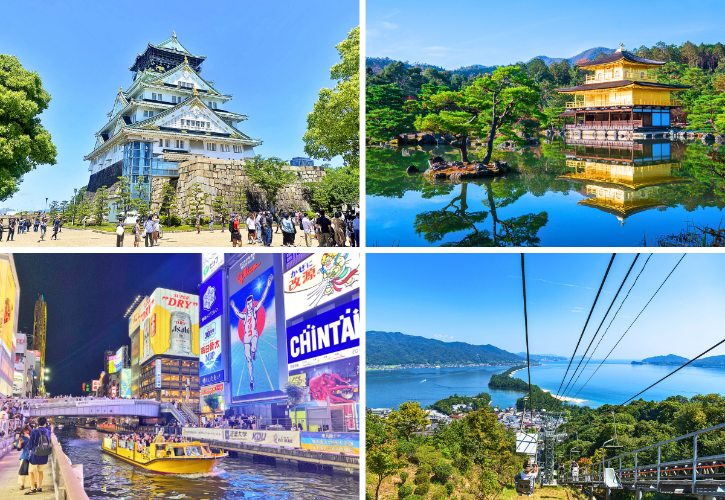
Planning a trip to Osaka and Kyoto?
This comprehensive 7-day itinerary covers exactly where you should stay, places you can’t miss, delicious foods you must try, and how to smoothly get around.
Let this guide save you time researching and help you enjoy an amazing journey. 😊
Day 1: Umeda and Osaka Castle
10:00 AM: Kansai International Airport to Osaka
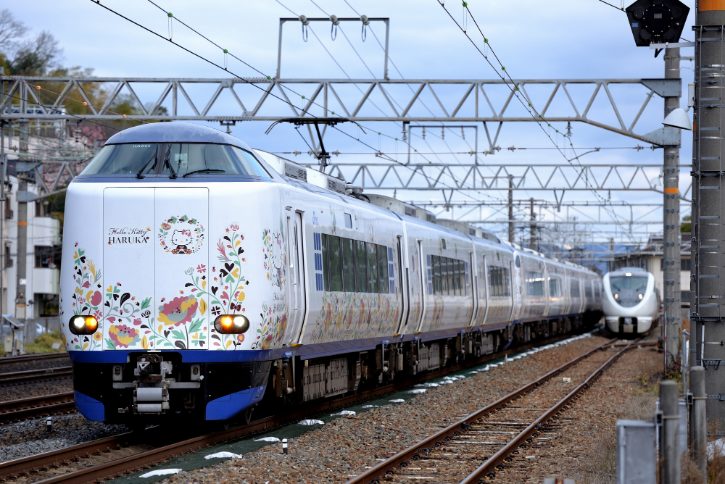
- From Kansai-Airport Station in Terminal 1, take the JR Haruka Express train directly to Osaka Station.
- The train station is conveniently located on the second floor of Terminal 1.
- The journey lasts about 45 minutes and costs ¥1,800, but it’s free if you’re using a JR Pass.
- The first train departs at 6:31 AM on weekdays and 6:40 AM on weekends, and the last train departs at 10:16 PM daily.
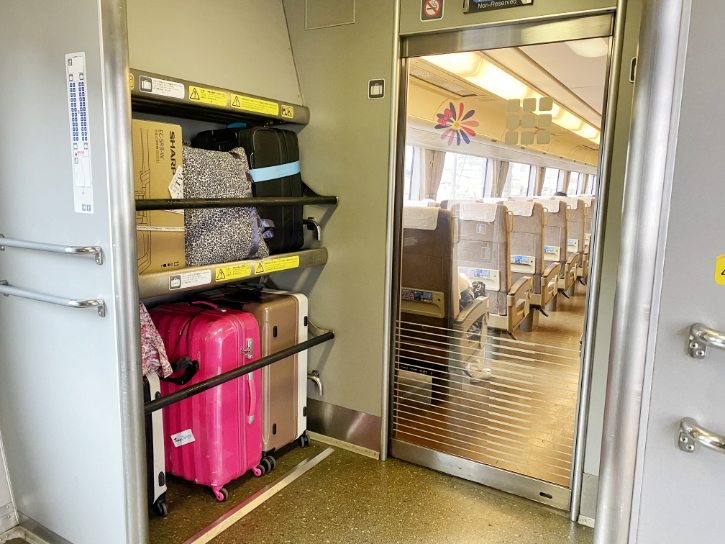
Take Note: The JR Haruka Express provides a direct connection to Osaka Station without any transfers and offers plenty of luggage storage space.
Read More: Kansai Airport to Osaka: The Fastest Ways to Get There
11:00 AM: Hotel Check-in at Umeda (Osaka)
a. Recommended Hotels
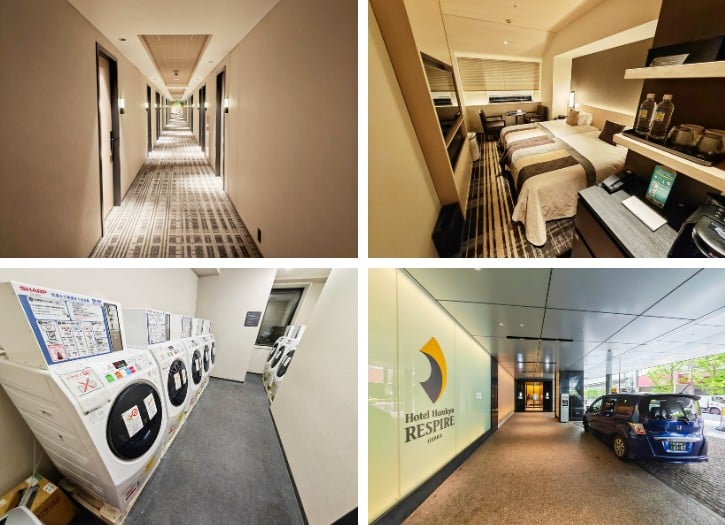
- Hotel Hankyu RESPIRE OSAKA (Booking.com | Agoda)
- Location & Transport:
- Directly connected to JR Osaka Station, making transportation very easy.
- Taxi stand located downstairs for quick trips.
- Room Facilities:
- Rooms feature separate bathrooms and modern toilets with washlet functions.
- Convenience:
- Coin laundry machines available; you can easily check your laundry status from your room’s TV.
- FamilyMart is located downstairs, and a 7-Eleven is nearby.
- Directly connected to LINKS UMEDA shopping mall, great for shopping and dining.
- Personal Experience:
- I’ve stayed here myself and found it very convenient and comfortable for exploring Osaka.
- Location & Transport:
- Hotel Granvia Osaka – JR Hotel Group (Booking.com | Agoda): Directly connected to JR Osaka Station, providing excellent accessibility.
- APA Hotel & Resort Osaka Umeda Eki Tower (Booking.com | Agoda): Cheap accommodation located within a 9 to 10-minute walk from Osaka-Umeda Station and JR Osaka Station.
- Hotel Dans Le Coeur Osaka Umeda (Booking.com | Agoda): Conveniently located within a 2 to 6-minute walk from Higashi-Umeda Station, Umeda Station, JR Osaka Station, and Osaka-Umeda Station.
b. Why Stay in Umeda?
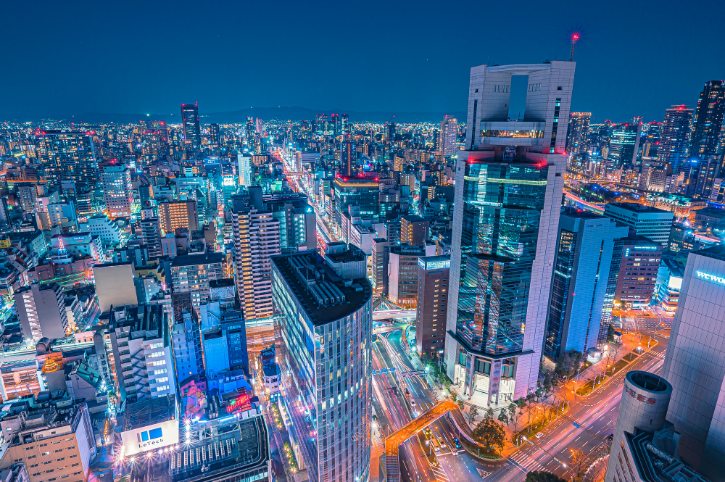
- Easy Access to Kansai Airport: You can reach Kansai International Airport directly from Umeda using the JR Haruka Express in about 45 minutes.
- Direct Train to Kyoto: Trains from JR Osaka Station in Umeda get you directly to Kyoto Station in roughly 29 minutes, making day trips convenient.
- Convenient Metro Lines: Several metro lines run through Umeda, letting you easily explore Osaka’s attractions.
- Multiple Train Stations:
- JR Osaka Station: Direct trains to Kyoto, Kobe, Himeji, Nara, and Kansai International Airport
- Hankyu Umeda Station: Direct access to Kyoto’s Kawaramachi area (popular for shopping and dining), Kobe (Sannomiya area), and Takarazuka (known for theaters and hot springs).
- Hanshin Umeda Station: Direct route to Kobe (Sannomiya and Kobe Harborland area).
Read More: Only 3 Best Places to Stay in Osaka
12:00 PM: Lunch near Osaka Station
a. Gyukatsu Motomura
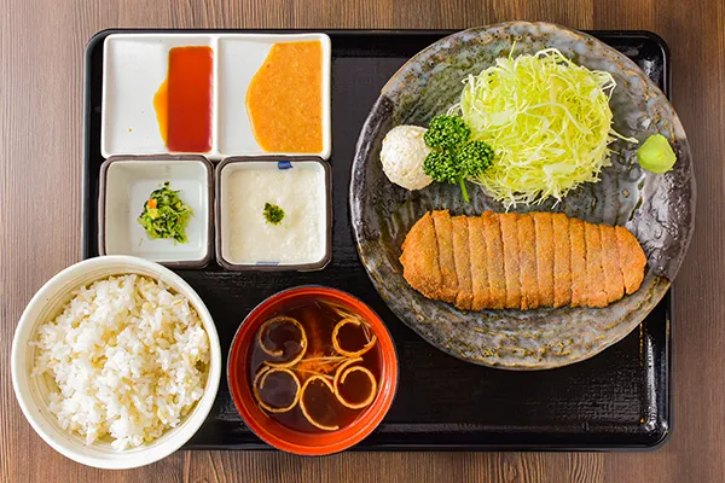
- What They Sell: Breaded beef cutlets (gyukatsu), crispy outside, rare inside, grilled by you on a hot stone at your table.
- Must-Try Dishes:
- Single Gyukatsu Set: Standard set includes beef cutlet, unlimited barley rice, miso soup, and sides.
- Double Gyukatsu Set: Great if you’re very hungry, double-sized meat portion with the same sides.
- Budget: About ¥1,930–¥3,060 per person. Single set is ¥1,930, double portion is ¥3,060.
b. Yakiniku Rikimaru Umeda Ohatsu Tenjin Branch
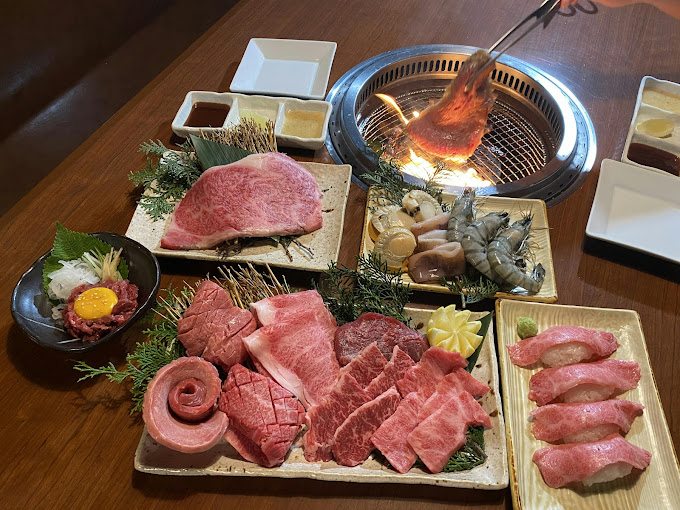
- What They Sell: Japanese BBQ (yakiniku), offering all-you-can-eat grilled meat at your table.
- Must-Try Dishes:
- Assorted Premium Cuts Platter: Sampler with high-quality steak cuts.
- Loin Steak: Tender and juicy steak pieces, popular choice.
- Thick-Cut Steak (Marbled Beef): Thick, flavorful beef chunks, grill quickly for best taste.
- Salted Beef Tongue: Extremely fresh chilled beef tongue, sliced in-store daily. Highly recommended dish to try.
- 90-Minute All-You-Can-Eat (Price):
- Wagyu Beef: ¥4,980
- Premium Course: ¥3,780
- Standard Course: ¥3,180
- 120-Minute All-You-Can-Eat (Price):
- Wagyu Beef: ¥5,280
- Premium Course: ¥4,080
- Standard Course: ¥3,480
How to Get to the Restaurants Listed Above from the Recommended Hotels
It’s a 2 to 10 minute walk from the hotels to Gyukatsu Motomura and Yakiniku Rikimaru Umeda Ohatsu Tenjin Branch.
1:00 PM: Tsuyuno Tenjinsya (Ohatsu Tenjin)
a. Overview
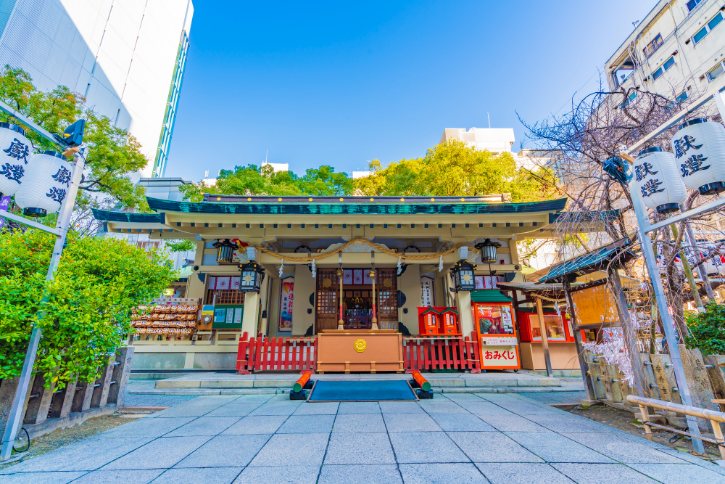
- What It Is: A small Shinto shrine in Osaka’s Umeda district dedicated to the deity of scholarship and love, linked to the tragic love story of Ohatsu and Tokubei.
- History: Edo-period shrine featured in the classic puppet play “Sonezaki Shinju” (The Love Suicides at Sonezaki), symbolizing eternal love and devotion.
- Why Visit: Experience Japanese cultural heritage in a peaceful setting; pray for academic success or relationship strength; connect with the romantic history that makes this shrine special.
- Atmosphere: Tranquil shrine nestled among modern buildings, surrounded by the vibrant Ohatsu Tenjin Shopping Street with its shops, eateries, and bars.
- Best For: Couples seeking romantic blessings, students praying for academic success, cultural explorers, and visitors wanting to write wishes on wooden ema prayer plaques.
b. What to Do at the Shrine
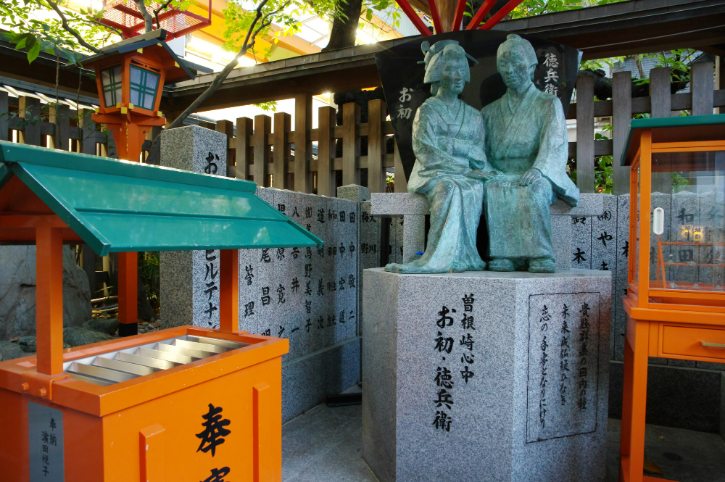
- Main Shrine (Honden): This is the heart of the shrine, where you can offer prayers. It’s dedicated to Sugawara no Michizane, the deity of scholarship and love.
- Ohatsu and Tokubei Statue: Look for the statue of the legendary lovers Ohatsu and Tokubei, whose tragic love story inspired the shrine’s reputation as a place for romance.
- Ema Plaques: Write your wishes on heart-shaped ema, a traditional way to pray for love and relationships
- Take Photos: The shrine is photogenic, especially the torii gate and the ema plaques area.
c. How to Get to Tsuyuno Tenjinsya (Ohatsu Tenjin) from the Recommended Restaurants Above
It’s a 2 to 5 minute walk from the restaurants to Tsuyuno Tenjinsha.
2:00 PM: Osaka Castle
a. Overview
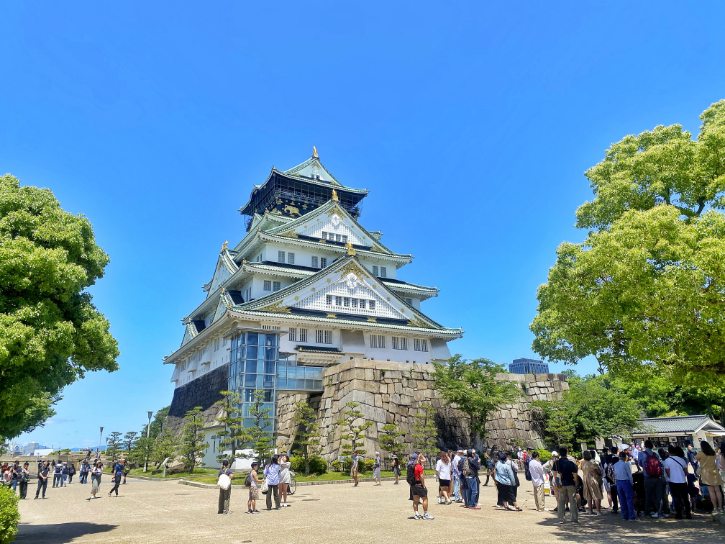
- What It Is: A famous Japanese landmark in Osaka, symbolizing rich history and cultural heritage with impressive architecture and city views.
- History: Built in 1586 by Toyotomi Hideyoshi as a power symbol, faced numerous battles including the Siege of Osaka, and was rebuilt several times. The current main tower is a 1931 concrete reconstruction.
- Why Visit: Experience Japan’s feudal past through historical exhibits and artifacts inside the castle. The surrounding park is perfect for picnics, especially during cherry blossom season.
- Atmosphere: Enjoy serene gardens and moats that offer a peaceful escape from city life, with scenic views and natural surroundings.
- Best For: History buffs, families, and Japanese culture enthusiasts. Features leisurely walking paths and an educational museum suitable for all ages.
b. Explore the Main Castle Tower

- 1st Floor (Introduction Film): Watch a short film about the castle’s fascinating history.
- 2nd Floor (Castle Construction): Learn how the castle was built and see replicas of golden roof decorations.
- 3rd Floor (Golden Tea Room): View a replica of Toyotomi Hideyoshi’s famous golden tea room.
- 4th Floor (Samurai Exhibits): Explore displays of samurai armor, weapons, and battle tactics.
- 5th Floor (Battle Paintings): See paintings depicting dramatic scenes from the Summer War of Osaka.
- 6th Floor (Closed Corridor): This floor is a corridor and is closed to visitors.
- 7th Floor (Miniature Displays): Check out miniature scenes showing important events from Toyotomi’s life.
- 8th Floor (Observation Deck): Enjoy stunning 360-degree views of modern-day Osaka.
Read More: A Complete Guide to Osaka Castle
c. Stroll Through the Castle Park
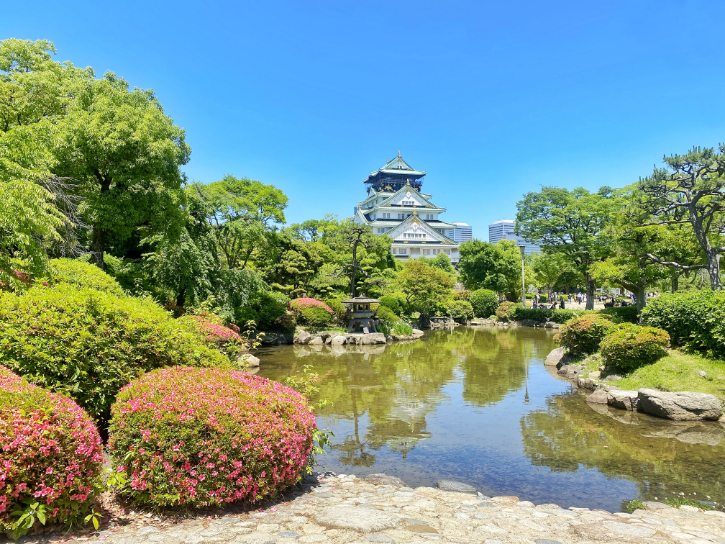
- Seasonal Scenery: The park around the castle is large and very beautiful, especially during cherry blossom season (late March to early April) and autumn (November).
- Nishinomaru Garden: Relax in this quiet garden, famous for its beautiful cherry blossoms in spring. There’s a small entry fee (¥200), but the views of the castle during cherry blossom season are worth it.
- Moats and Stone Walls: Take an easy walk along the castle’s huge stone walls and moats. You’ll be impressed by their size and detailed craftsmanship.
d. How to Get to Osaka Castle from Tsuyuno Tenjinsya
Take the Osaka Metro Tanimachi Line from Higashi-Umeda Station to Tanimachi 4-chome Station for ¥240 in 7 minutes. Use Exit 9 and walk 15 minutes to Osaka Castle.
5:00 PM: Grand Green Osaka
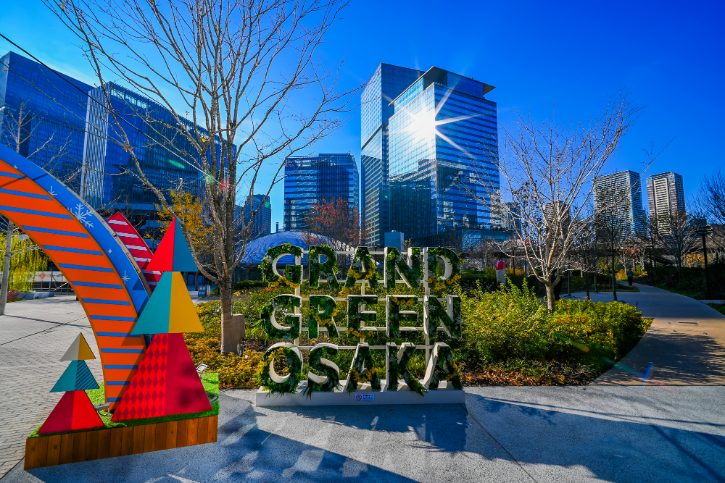
Grand Green Osaka is a modern complex conveniently located next to Osaka Station in the busy Umeda area.
It has three main sections: North Building, South Building, and Umekita Park.
Each area offers its own special experiences, including shops, restaurants, relaxing areas, and unique attractions.
a. North Building
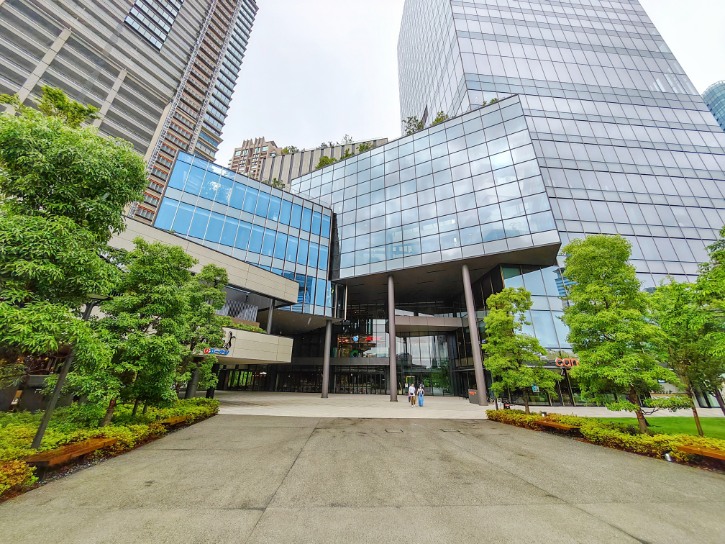
The North Building is a relaxing area with nature-themed shopping, casual dining, and comfortable amenities.
- Gardens Umekita Shop: A lifestyle and gardening store perfect for plant lovers.
- Patagonia Osaka Umeda: Large store specializing in outdoor clothing and gear.
- Koko Head Cafe: Casual Hawaiian cafe serving delicious brunch dishes and coffee.
- Jackson Garden Cafe: Relaxing cafe surrounded by trees, great for snacks or desserts.
- Tully’s Coffee × Yurindo: Bookstore café, perfect for relaxing with coffee and books.
b. South Building
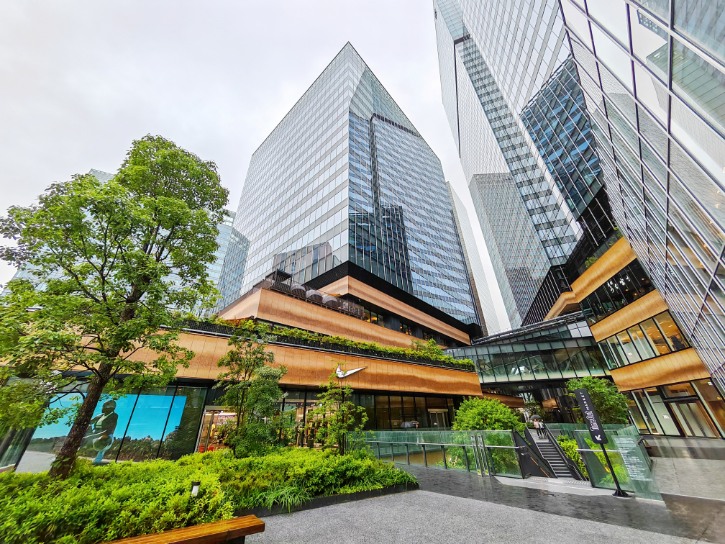
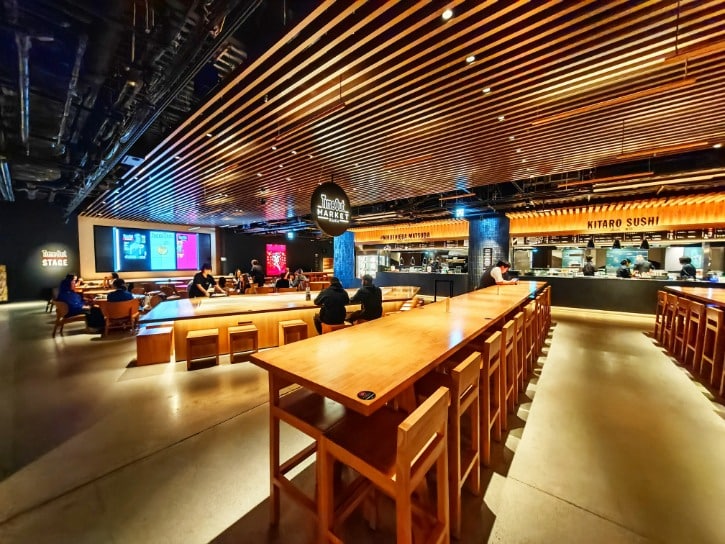
The South Building is focused on wellness, dining, and modern shopping, featuring many trendy shops and relaxing attractions.
- Umekita Onsen (Hot Spring): Large, relaxing hot spring facility with infinity pool views.
- Time Out Market Osaka: Popular food court with top local eateries; great for diverse tastes.
- Grand Chefs’ Valley: Counter-style dining where chefs cook directly in front of you.
- Umekita Grand Tables: Sit-down restaurants, serving steak, Italian food, and Japanese dishes.
- Shopping Choices: Fashionable clothing boutiques, lifestyle, tech, and home goods stores.
c. Umekita Park
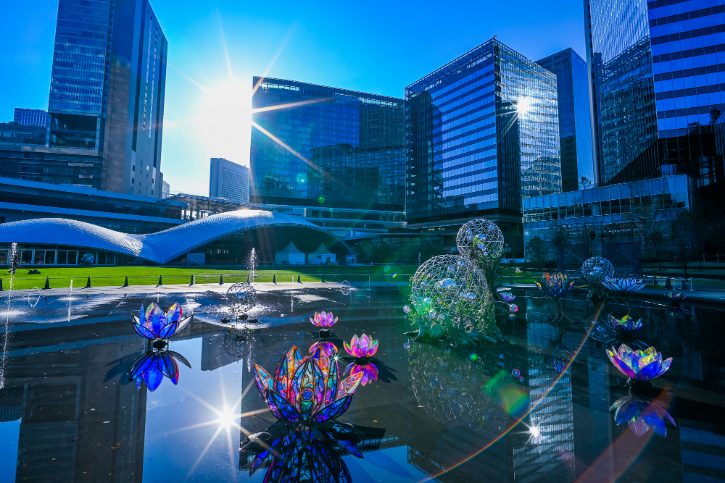
- Open Green Space: Big park next to Osaka Station; ideal for relaxing, picnics, and outdoor breaks.
- Public Events: Frequently hosts outdoor concerts, yoga sessions, markets, and community events.
d. How to Get to Grand Green Osaka from Osaka Castle
Take the Osaka Loop Line from Ōsakajō-kōen Station to Osaka Station for ¥170 in 10 minutes. Exit via the West Exit, which connects to Grand Green Osaka.
6:30 PM: Umeda Sky Building (Kuchu Teien Observatory)
a. Overview
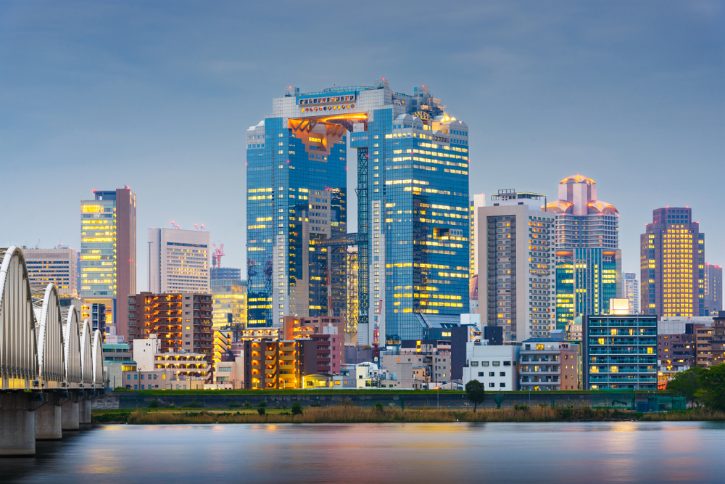
- What It Is: A 173-meter skyscraper in Osaka with twin 40-story towers connected by the Kuchu Teien Observatory (“Floating Garden”) offering panoramic city views.
- History: Designed by Hiroshi Hara (1993) as part of Kita district renewal; originally planned as four towers; recognized among world’s top 20 buildings in 2008.
- Why Visit: Enjoy unmatched views from the open-air Sky Walk (best at sunset), ride glass-enclosed escalators between towers, and add your padlock to the Heart Lock installation on the rooftop.
- Atmosphere: Experience the contrast between modern architecture and nostalgic Takimi Koji area, perfect for viewing Osaka’s transition from day to night.
- Best For: You’re looking for beautiful city views or you’re an architecture enthusiast. It’s also perfect for couples seeking romantic sunset views and the Heart Padlock tradition on the rooftop.
b. Kuchu Teien Observatory Highlights
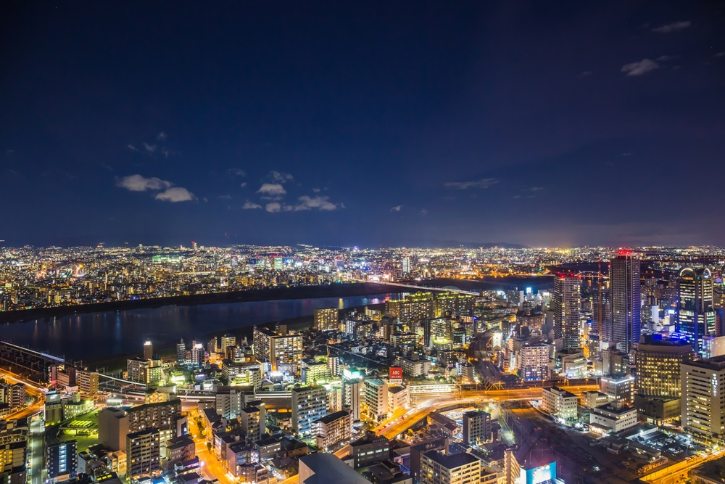
- Arrival Floor (35F): Elevators take you quickly up to the 35th floor, where you transfer to the famous glass escalators.
- Glass Escalators (35F–39F): Unique, enclosed glass escalators carry you between towers, providing dramatic city views during the ascent.
- Indoor Observatory (39F): Main indoor observation floor with large panoramic windows, a gift shop, information area, and access to cafés and restaurants.
- Sky 40 Café (40F): Comfortable café offering drinks, snacks, and international beers with seating along wide windows, giving impressive views of Osaka below.
- Open-air Rooftop (Sky Walk): The rooftop “Floating Garden” observatory offers spectacular open-air, 360-degree views at a height of 173 meters, ideal for photography and enjoying the breeze.
- Nighttime Experience (Lumi Sky Walk): At night, the rooftop floor lights up with glowing patterns, creating a memorable experience.
Extra Tip:
Takimi Koji (B1F): Retro-themed underground street featuring traditional restaurants serving local Osaka dishes.
c. How to Get to Umeda Sky Building from Grand Green Osaka
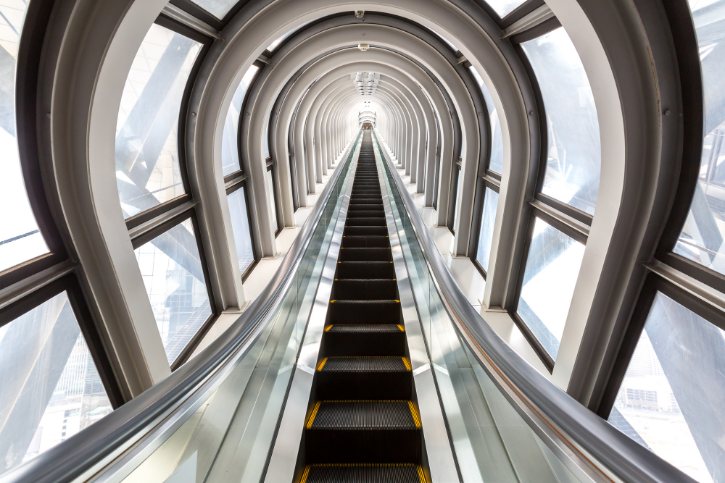
- Walk about 5 minutes to Umeda Sky Building.
- Take the escalator to the 3rd floor.
- Take the elevator from the 3rd floor to the 35th floor.
- From the 35th floor, use the glass-enclosed escalator connecting the two towers to reach the 39th floor.
- Proceed from the 39th floor up to the rooftop observatory on the 40th floor.
8:00 PM: Dinner near Osaka Station
a. Hakodate Gourmet Kaitenzushi Kantaro Grand Front Osaka
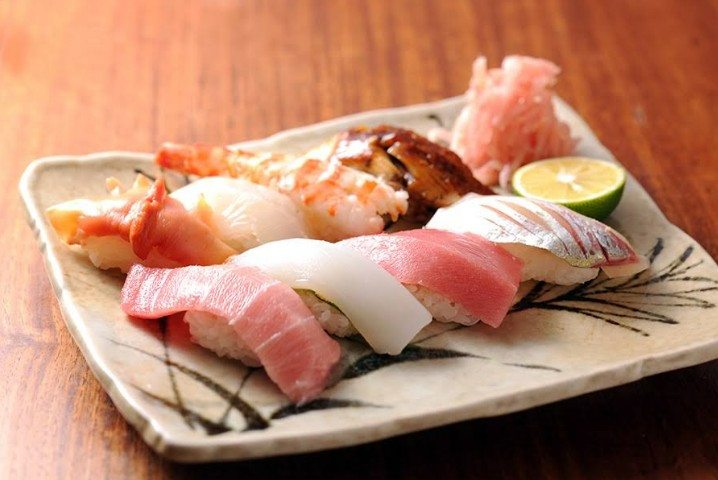
- What They Sell: Conveyor-belt sushi with fresh seafood from Hokkaido.
- Must-Try Dishes: Fatty Tuna (otoro), Scallops (hotate), Salmon Roe Sushi (ikura), Seared Fluke Fin (engawa).
- Budget: Expect about ¥3,000–¥4,000 per person.
b. Menya Takei Hankyu Umeda
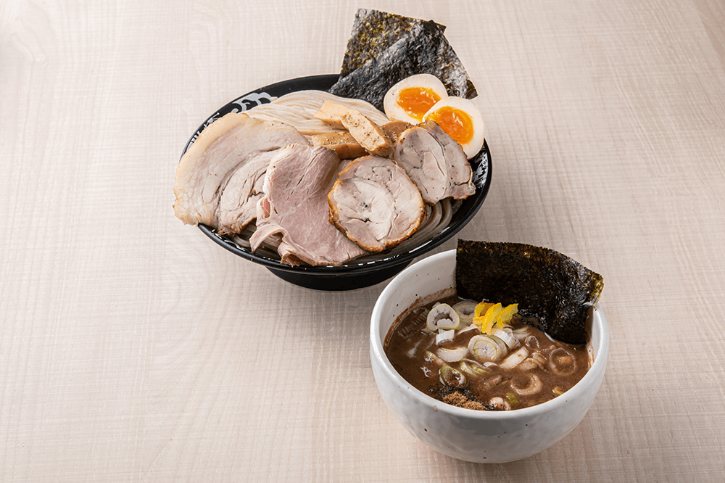
- What They Sell: Ramen and dipping noodles (tsukemen) with rich pork and seafood broth.
- Must-Try Dishes: Special tsukemen (thick noodles with rich dipping broth, topped with pork, chicken, and egg) and spicy pork rice bowl (side dish).
- Budget: Basic ramen or tsukemen costs ¥980–¥1,110. Special dishes around ¥1,240+. Total budget ¥1,000–¥1,600 per person.
c. Ichiran Umeda
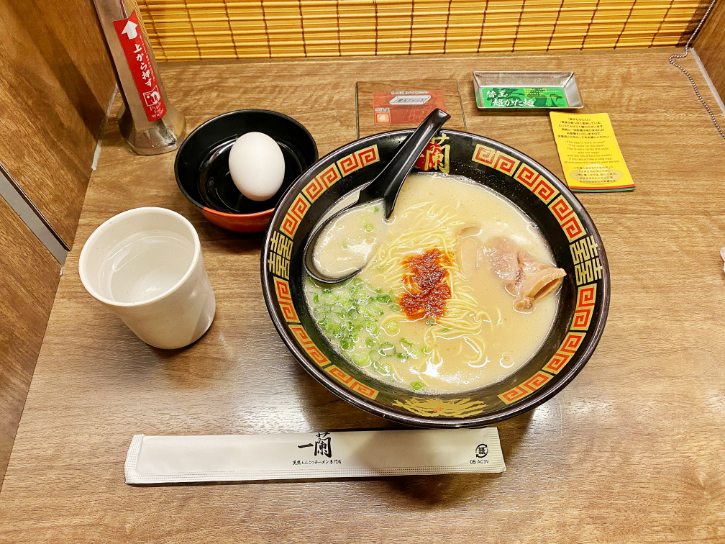
- What They Sell: Specializes in pork-bone broth ramen (tonkotsu ramen).
- Must-Try Dishes: Classic Ichiran tonkotsu ramen with thin noodles, secret spicy red sauce, and pork slices. Try the noodle refill (“kaedama”) if still hungry.
- Budget: Basic ramen is ¥1080. Extra toppings ¥130–¥260 each, noodle refill ¥210. Budget around ¥1,000–¥1,500 per person.
How to Get to the Restaurants Above from Umeda Sky Building
It’s just a 10 to 12 minute walk from Umeda Sky Building to Hakodate Gourmet Kaitenzushi Kantaro Grand Front Osaka, Menya Takei Hankyu Umeda, and Ichiran Umeda.
Day 2: Shinsekai, Kuromon Ichiba Market, Dotonbori and Shinsaibashi Shopping Street
9:30 AM: Shitennoji Temple
a. Overview
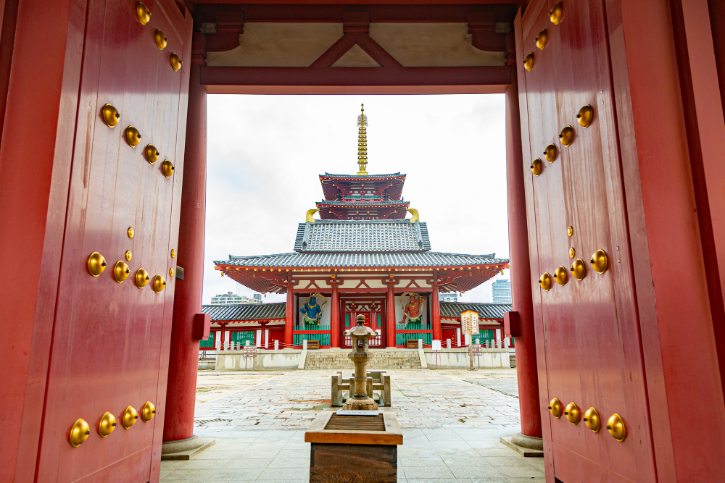
- What It Is: One of Japan’s oldest Buddhist temples, founded in 593 by Prince Shotoku and dedicated to the Four Heavenly Kings.
- History: Established to promote Buddhism in Japan, rebuilt several times after fires and wars while preserving its original 6th-century design.
- Why Visit: Experience ancient Buddhist heritage through the five-story pagoda, main hall (Kondo), and lecture hall (Kodo) featuring traditional Japanese architecture.
- Atmosphere: Peaceful retreat from Osaka’s busy city life with serene gardens, tranquil ponds, and a calming environment.
- Best For: History enthusiasts, architecture lovers, spiritual seekers, photographers, and those seeking a quiet place to reflect.
b. Things to Do and See
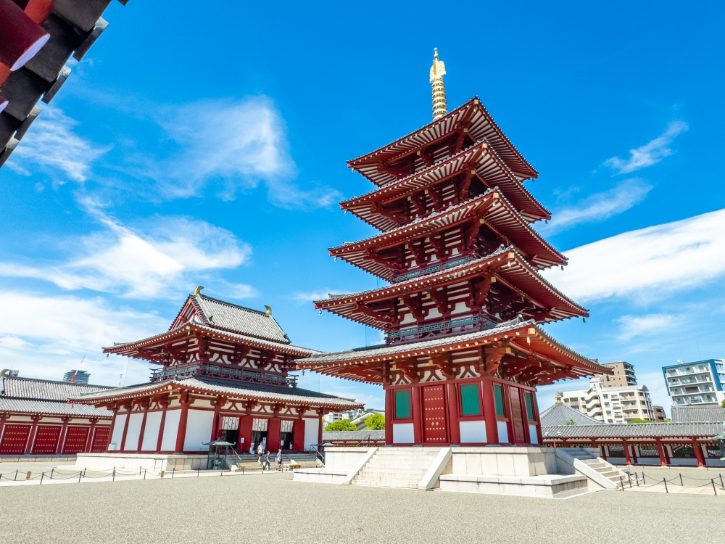
- Five-Story Pagoda: You can climb inside for great views. Remember to remove your shoes and no photos allowed inside.
- Main Hall (Golden Pavilion): The temple’s spiritual heart housing important Buddhist statues. Observe quietly as locals pray here.
- Gokuraku-jodo Garden: Beautiful garden with a pond and cherry blossoms (best in spring). Entry fee is ¥300.
- Treasure House Museum: Displays ancient Buddhist art and statues. Entry fee is ¥500.
- Grand Gates and Stone Torii: Impressive gates marking entrances, great for photos and exploring history.
Read More: A Complete Guide to Shitennoji Temple
c. How to Get to Shitennoji Temple from Higashi-Umeda Station
Take the Osaka Metro Tanimachi Line from Higashi-Umeda Station to Shitennoji-mae Yuhigaoka Station for ¥240 in 13 minutes. Use Exit 4 and walk 4 minutes to Shitennoji Temple.
11:00 AM: Shinsekai
a. Overview
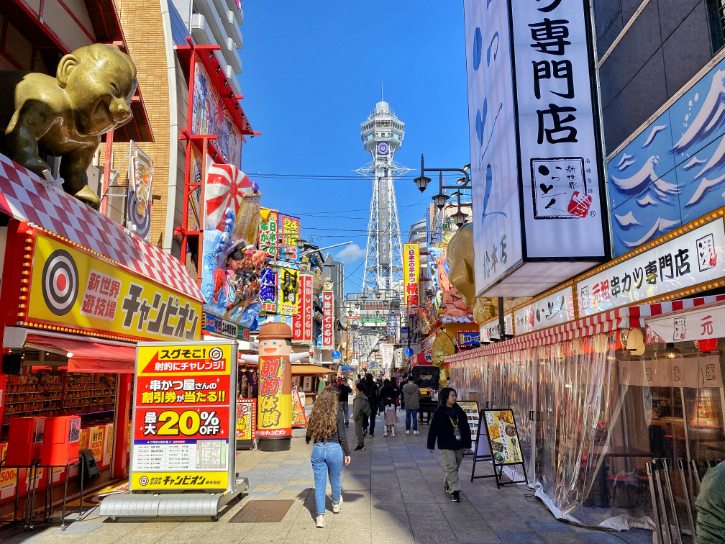
- What It Is: A colorful “New World” neighborhood in Osaka featuring the iconic Tsutenkaku Tower, vibrant streets, and authentic local eateries.
- History: Built in 1912 with inspiration from New York and Paris, Shinsekai experienced decline after WWII but has since been revitalized into a popular destination.
- Why Visit: Experience a blend of old and new Osaka, taste kushikatsu (deep-fried skewers), explore retro arcades, and enjoy panoramic city views from Tsutenkaku Tower.
- Atmosphere: Discover a nostalgic vibe with neon lights, vintage signs, and bustling eateries that showcase Osaka’s authentic culture.
- Best For: You’ll love Shinsekai if you’re interested in traditional street life, local food, and unique attractions like Tsutenkaku Tower and nearby Spa World.
b. What to Do and See

- Take Quirky Photos: Capture fun moments with Shinsekai’s unique icons, including giant signs, colorful lanterns, and the Billiken statue – perfect for memorable selfies or group photos.
- Enjoy Local Cuisine: Try Shinsekai’s famous kushikatsu (deep-fried skewers), takoyaki (octopus balls), and doteyaki (braised beef tendon).
- Tsutenkaku Tower: Shinsekai’s iconic tower, about 103 meters high. Go up for great city views and to rub the feet of the lucky Billiken statue.
- Explore Janjan Yokocho: This lively narrow street is packed with small eateries and bars. It’s a great place to eat, drink, and experience local life.
- Browse Shinsekai Market: Shop for affordable souvenirs, traditional sweets, and quirky local goods in the covered market area.
c. How to Get to Shinsekai from Shitennoji Temple
It’s a 15-minute walk from Shitennoji Temple to Shinsekai.
12:00 PM: Lunch in the Shinsekai Area
a. Kura Sushi Shinsekai Tsutenkaku Branch
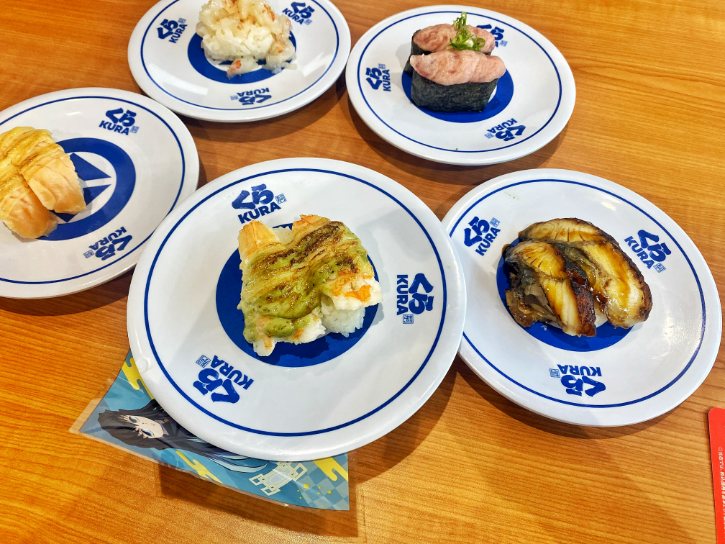
- What They Sell: Conveyor belt sushi restaurant offering fresh sushi, noodles, fried snacks, and desserts. Good for all ages.
- Must-Try Dishes: Aburi Shrimp Basil Cheese, Grilled Eel, Fresh Tuna Nigiri, Salmon, Shrimp Sushi.
- Budget: Budget-friendly, average ¥1,000–¥1,500 per person.
b. Kushikatsu Daruma
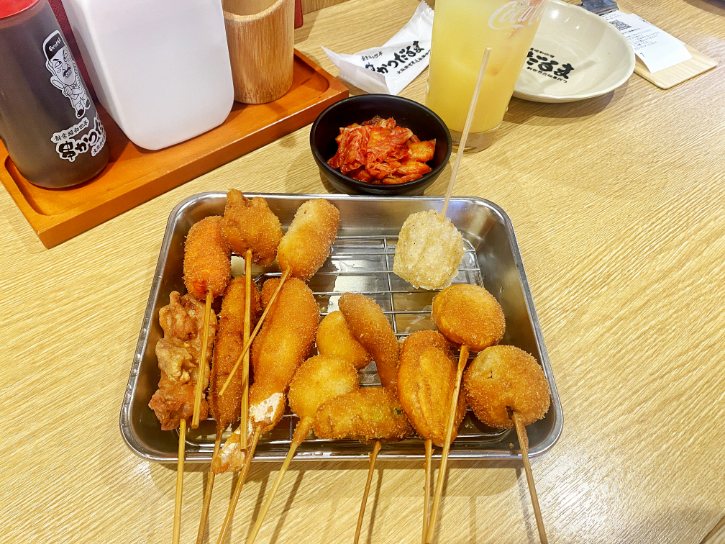
- What They Sell: Osaka-style deep-fried skewers (kushikatsu) with meat, seafood, vegetables, and more.
- Must-Try Dishes:
- New World Set: Popular set with assorted skewers like pork, shrimp, sausage, cheese chikuwa (fish cake with cheese), veggies, and Doteyaki (beef tendon stew).
- Dotonbori Set: Another good set with pork, shrimp, sausage, cheese chikuwa, and Doteyaki stew.
- Recommended Individual Skewers: Beef (original), pork, shrimp, asparagus, cheese chikuwa.
- Dining Tip: Dip skewers once only in the shared sauce. Use provided cabbage for extra sauce.
- Budget: Expect around ¥1,700–¥2,800 per person.
1:30 PM: Namba Yasaka Jinja
a. Overview

- What It Is: A Shinto shrine in Osaka featuring a huge 12-meter-tall lion-head structure, believed to protect you by swallowing evil spirits.
- History: Over 950 years old; originally built around 1069, destroyed in WWII, and rebuilt in 1974.
- Why Visit: Unique architecture, calm surroundings, and popular for seeking good luck in studies and business.
- Atmosphere: Peaceful and relaxing, especially pretty during cherry blossom season.
- Best For: You’re seeking something unique or you’re a photographer. It’s also ideal if you want a quiet place to unwind in the city.
b. Exploring the Shrine Grounds

- Best Photo Spot: Stand in front of the lion head for a memorable photo. The open space in front of the stage makes it easy to capture the entire structure.
- Main Hall (Honden): Pay your respects at the main hall, where you can offer a small donation, bow, and clap your hands to pray.
- Ema Plaques: Write your wishes on wooden plaques (ema) and hang them at the shrine. It’s a fun and meaningful activity.
- Omikuji Fortunes: Draw a fortune slip (omikuji) to see your luck. If it’s bad, you can tie it to a designated area to leave the misfortune behind.
- Charm and Amulet Shop: Browse the shop for unique charms (omamori) for luck, health, or success. They make great souvenirs.
Read More: A Compelete Guide to Namba Yasaka Shrine
c. How to Get to Namba Yasaka Jinja from the Restaurants Above
Take the Osaka Metro Midosuji Line from Dobutsuen-Mae Station to Daikokucho Station for ¥190 in 2 minutes. Use Exit 2 and walk 7 minutes to Namba Yasaka Jinja.
3:00 PM: Kuromon Ichiba Market
a. Overview

- What It Is: Kuromon Ichiba is a lively, covered market stretching about 600 meters, with over 150 shops and stalls.
- History: Established in 1902, known locally as “Osaka’s Kitchen”. Famous for fresh foods and daily supplies.
- Why Visit: It’s the perfect place to taste Osaka’s famous street food, buy fresh produce, and experience local culture.
- Atmosphere: Expect a mix of bustling energy, friendly vendors, and mouthwatering smells.
- Best For: Food lovers, photographers, and anyone looking for an authentic Osaka experience.
b. Must-Try Foods
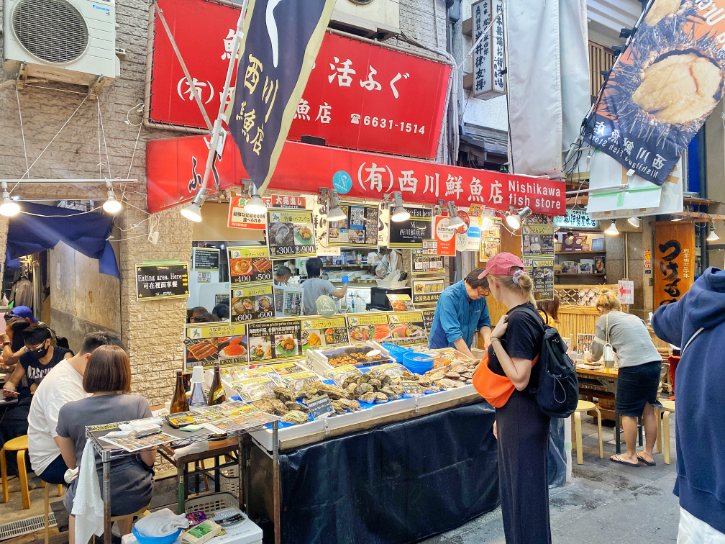
- Fresh Seafood: Try raw tuna, salmon sashimi, grilled scallops, oysters, or king crab legs. Prices range from ¥500–¥2,500+ depending on type and size.
- Wagyu Beef Skewers: High-quality grilled beef sticks (like Kobe or Matsusaka beef), tender and juicy. Usually ¥1,000–¥2,500 per skewer, depending on quality.
- Takoyaki (Octopus Balls): Crispy outside, soft inside, topped with sauce and mayo. About ¥500–¥600 for 6–8 pieces.
- Oden (Hotpot Snacks): Simple, comforting food like radish, egg, tofu, and fishcakes cooked in broth. Affordable at ¥100–¥200 per item.
- Sweets & Snacks: Try strawberry daifuku (mochi with sweet bean paste and strawberry), taiyaki (crispy fish-shaped pancakes), or dorayaki (pancake sandwich). Prices about ¥200–¥300 each.
- Fresh Fruits & Juices: Seasonal fruits like strawberries or melons on sticks or as juices. Prices from ¥300–¥800 depending on type.
c. How to Get to Kuromon Ichiba Market from Namba Yasaka Jinja
It’s a 15-minute walk from Namba Yasaka Jinja to Kuromon Ichiba Market.
5:00 PM: Dotonbori
a. Overview

- What It Is: Dotonbori is a lively area along a canal in Osaka, known for delicious food, bright neon signs, shopping, and nightlife.
- History: Established over 400 years ago; originally famous for theaters and entertainment. Today, it’s Osaka’s top food and nightlife district.
- Why Visit: To experience Osaka’s famous food, vibrant atmosphere, and iconic sights like the Glico Running Man billboard.
- Atmosphere: Busy, vibrant, and fun, especially at night when crowds gather around bright neon lights and food stalls. Expect a lively, carnival-like feeling.
- Best For: Food lovers, nightlife enthusiasts, and anyone wanting an exciting introduction to Osaka’s food and entertainment culture.
b. Food Recommendations
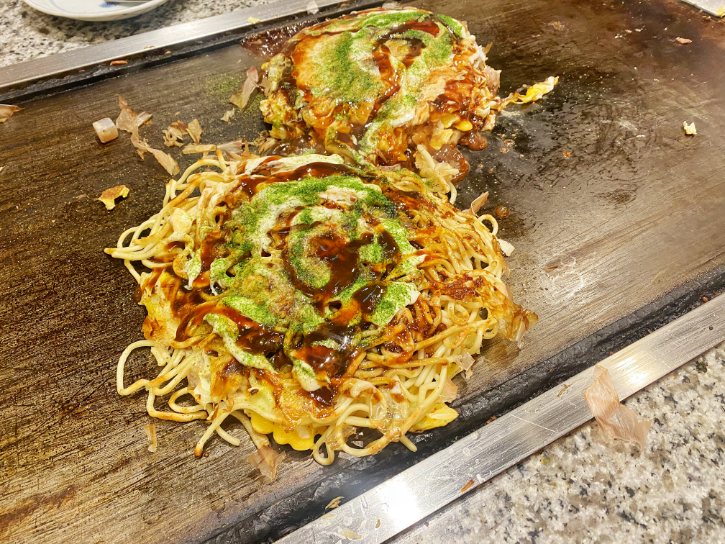
- Okonomiyaki (Mizuno): A savory pancake with various toppings like pork or seafood, cooked on a hot grill.
- Takoyaki (Takoyaki Wanaka): Small balls filled with octopus, topped with sauce and bonito flakes. Try them fresh at street stalls.
- Kushikatsu (Kushikatsu Daruma): Deep-fried skewers of meat or vegetables. Famous places include Kushikatsu Daruma. Remember: dipping sauce only once per skewer.
- Ramen (Kinryu Ramen | Dotombori Kamukura Sennichimae): Try Kinryu Ramen for rich pork broth (open 24 hours) or Dotombori Kamukura Sennichimae for tasty clear-broth ramen.
- Seafood and Crab (Kani Doraku): Iconic crab restaurant with a giant moving crab sign. It’s pricey, so street stalls selling crab snacks nearby offer cheaper alternatives.
Read More: 17 Best Street Foods to Try at Dotonbori Osaka
c. Sightseeing Spots

- Glico Running Man Sign: Iconic neon sign above the Ebisubashi Bridge, famous for selfies.
- Giant Signboards: Look out for famous moving signs, like the giant crab at Kani Doraku and the dragon at Kinryu Ramen – great for photos.
- Ebisubashi Bridge & Dotonbori Canal: Main pedestrian bridge with great views of illuminated billboards and canal. Good for daytime and nighttime photos.
- Hozenji Yokocho Alley & Temple: Quiet, lantern-lit street near Dotonbori, offering traditional restaurants and the famous moss-covered Buddha statue at Hozenji Temple.
- Don Quijote Ferris Wheel (Ebisu Tower): Oval-shaped Ferris wheel attached to the Don Quijote store, offering unique views over Dotonbori. Fun, quick ride (about 15 mins).
- River Cruises: Short boat tours along the canal, especially scenic at night, good for photos (about 20 mins).
d. How to Get to Dotonbori from Kuromon Ichiba Market
It’s a 6-minute walk from Kuromon Ichiba Market to Dotonbori.
6:30 PM: Dinner in the Dotonbori
a. Dotonbori Kamukura Sennichimae

- What They Sell: Ramen restaurant specializing in soy sauce-based broth, famous for rich but mild flavor.
- Must-Try Dishes:
- Oishii Ramen (Delicious Ramen): Signature ramen with pork and Chinese cabbage.
- Gyoza (Dumplings): Crispy fried dumplings, popular side dish.
- Budget:
- Ramen dishes are priced between ¥820 to ¥1,270.
- Side dishes like gyoza is ¥280.
b. Daiki-suisan Kaitenzushi
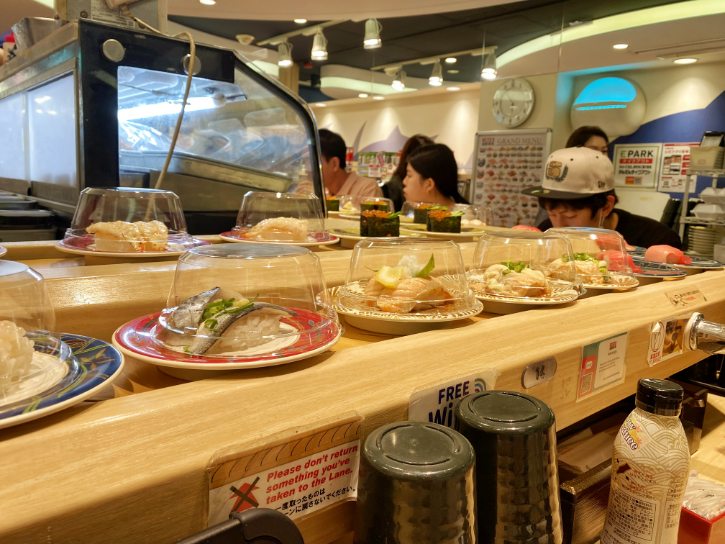
- What They Sell: Conveyor-belt sushi offering fresh, affordable sushi.
- Must-Try Dishes: Fresh Salmon, Scallops, Sea urchin (uni), and Sweet Shrimp.
- Budget: ¥100–¥700 per plate; average meal about ¥1,500–¥3,000 per person, depending on your choices.
c. Daibokujou Dotonbori
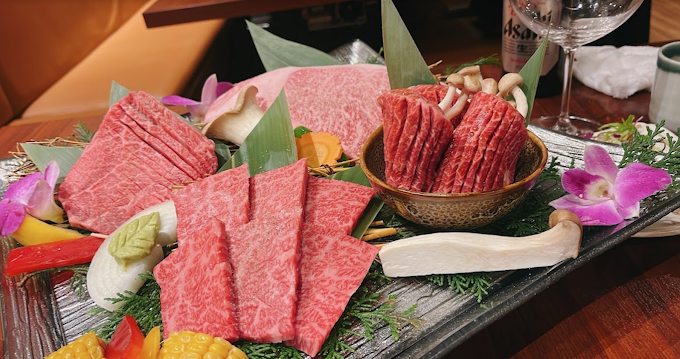
- What They Sell: Japanese BBQ restaurant (yakiniku), specializing in high-quality Wagyu beef grilled at your table.
- Must-Try Dishes:
- All-You-Can-Eat Wagyu BBQ: Unlimited order of premium beef cuts, sides, and vegetables for a fixed price.
- A5 Kobe Beef Set: Premium option offering authentic Kobe beef known for its soft texture and rich taste.
- Budget: Around ¥5,500–¥8,000 per person for all-you-can-eat options; average spend about ¥6,000 per person for a full experience.
7:30 PM: Shinsaibashi-Suji Shopping Street
a. Overview
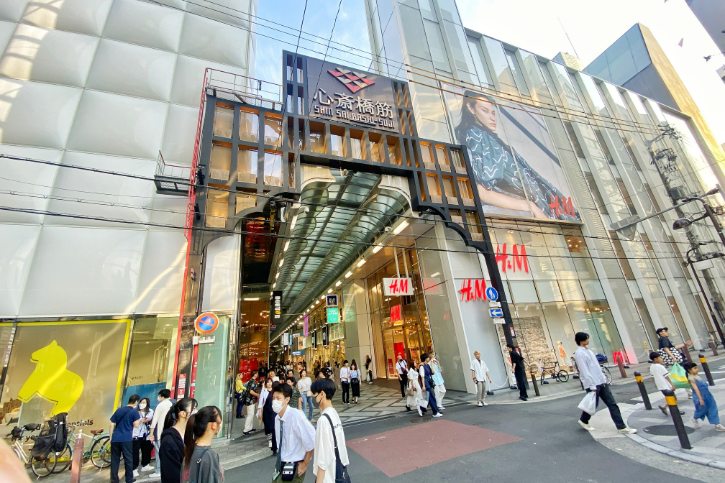
- What It Is: A covered shopping arcade in Osaka featuring fashion stores, cosmetics shops, restaurants, and cafes.
- History: 400-year-old merchant area that began near Shinsaibashi Bridge and developed into Osaka’s busiest and most iconic shopping district.
- Why Visit: Shop from over 180 stores, experience local fashion trends, explore Japanese cosmetics, and enjoy street snacks all in one convenient location.
- Atmosphere: Vibrant and bustling with bright lights, energetic crowds, and a lively shopping vibe; covered street provides comfort in any weather.
- Best For: You’re shopping for fashion, cosmetics, or souvenirs. It’s also great if you love food or want to experience authentic Osaka urban life.
b. Fashion
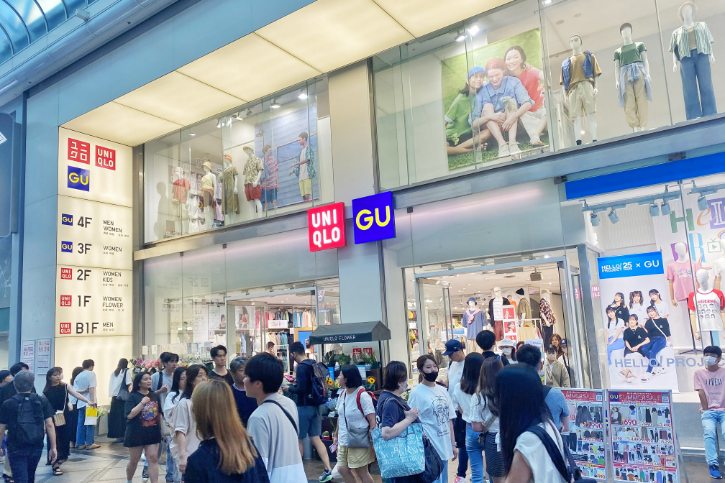
Budget-Friendly Options
- UNIQLO: Quality casual clothing at affordable prices.
- GU: Trendy Japanese fast-fashion brand, great for budget shopping.
- H&M, ZARA: International chains for stylish clothing at mid-range prices.
- WEGO and Lowry’s Farm: Fun, youthful Japanese fashion stores for casual clothing and accessories.
Luxury Shopping Experiences
- Daimaru Shinsaibashi: Famous department store offering high-end fashion brands, excellent customer service, and tax-free shopping.
- Midosuji Street: Next to Shinsaibashi arcade, home to luxury boutiques like Chanel, Louis Vuitton, Dior, and Cartier.
c. Cosmetics
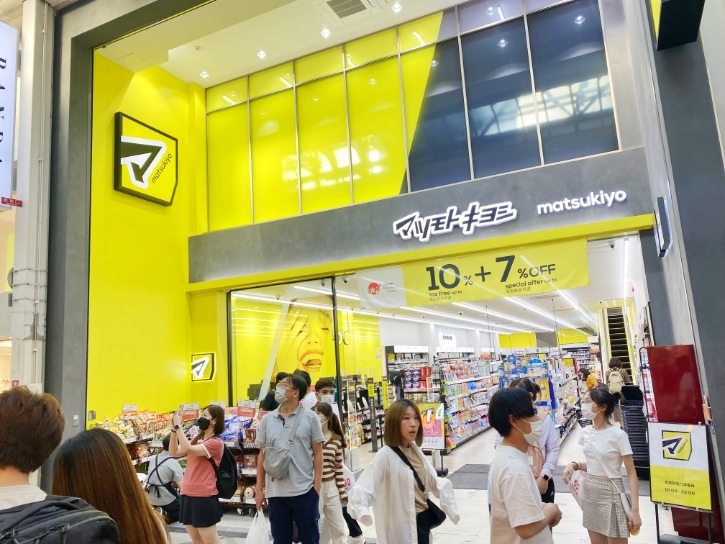
Budget-Friendly Options
- Matsumoto Kiyoshi and Daikoku Drug: Popular Japanese drugstores selling affordable beauty products, skincare, makeup, health items, and snacks, often at discounted prices with tax-free options.
- Korean Cosmetics Shops: Find affordable Korean skincare and makeup products popular in Japan.
- LUSH: Handmade cosmetics, bath bombs, and skincare products with attractive displays.
Luxury Beauty Options
- Daimaru Department Store beauty floor: High-end brands like SK-II, Shiseido, Clé de Peau Beauté, and POLA.
- LAOX Duty-Free Shop (in Daimaru): Premium cosmetics and skincare sets tailored for tourists, tax-free, with multilingual staff.
d. How to Get to Shinsaibashi-Suji Shopping Street from Dotonbori
It’s a 2-minute walk from Dotonbori street to Shinsaibashi-Suji Shopping Street.
Read More: Shinsaibashi-Suji Shopping Street: Visitor’s Guide and Map
Day 3: Universal Studios Japan
a. Overview
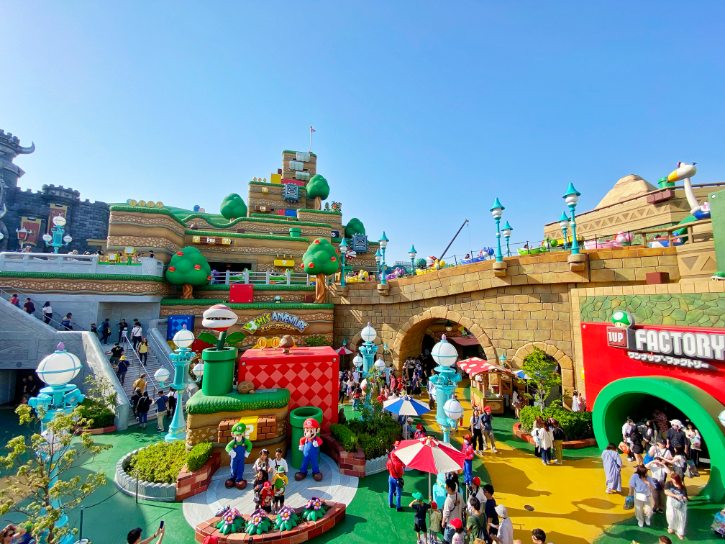
- What It Is: A popular theme park in Osaka, offering rides and attractions based on movies, games, and Japanese pop culture.
- History: Opened in 2001; added Harry Potter (2014), Minion Park (2017), Super Nintendo World (2021), and Donkey Kong Country (December 2024).
- Why Visit: Unique experiences like Super Nintendo World, immersive Harry Potter attractions, exciting thrill rides, and family-friendly zones.
- Atmosphere: Vibrant, fun, and immersive, with detailed areas like Jurassic Park, Harry Potter’s village, and Mario’s Mushroom Kingdom.
- Best For: You’re a thrill-seeker, gamer, or pop culture fan. It’s also great for families with kids and anyone visiting Osaka for the first time.
b. Best Thrill Rides
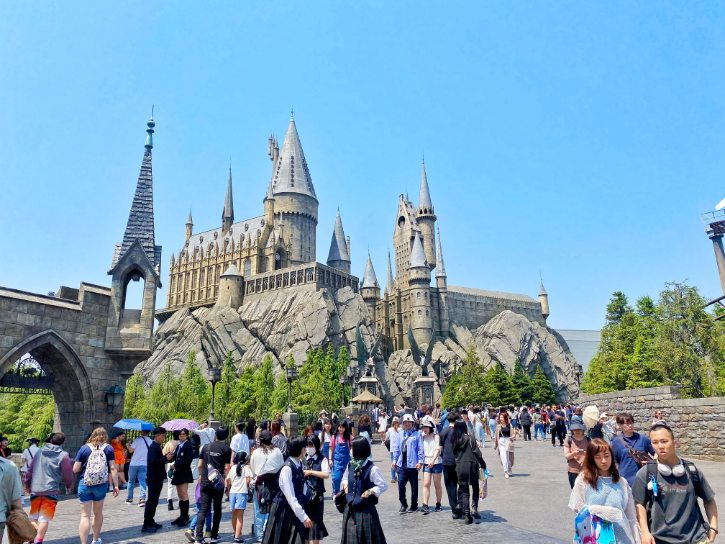
- Harry Potter and the Forbidden Journey: Exciting simulator ride through Harry Potter’s world (no big drops but thrilling motion).
- The Flying Dinosaur: Intense coaster in Jurassic Park; riders fly face-down, experiencing loops and high speeds.
- Hollywood Dream – The Ride (Backdrop): High-speed roller coaster with a backward option (“Backdrop”) that adds extra thrills.
- Jurassic Park: The Ride: Boat ride ending with a huge water splash drop; thrilling and refreshing.
- Mario Kart: Koopa’s Challenge: Interactive racing ride in Super Nintendo World; fun, moderately thrilling with AR technology.
c. Best Family-Friendly Attractions

- Despicable Me Minion Mayhem: Family-friendly motion-simulator ride, enjoyable for Minion fans of all ages.
- Universal Wonderland: Gentle rides and play zones themed around Snoopy, Hello Kitty, and Sesame Street characters – perfect for young kids.
- Super Nintendo World & Donkey Kong Country: Enjoy family-friendly rides like Yoshi’s Adventure (very gentle) and the new Mine Cart Madness (moderate thrill).
- Flight of the Hippogriff: Mild, kid-friendly roller coaster in the Harry Potter area; suitable for younger children.
d. Tips for Visitors (including Donkey Kong Country Access)

- Buy Tickets Online: Avoid long entry lines by getting tickets online
- Visit Early & on Weekdays: Go early on weekdays (especially Wednesday or Thursday) to beat the crowds.
- Timed-Entry to Super Nintendo World & Donkey Kong Country:
- Reserve free timed-entry tickets through the official USJ app immediately upon entering the park.
- Donkey Kong Country is part of Super Nintendo World; no extra reservation is needed.
- Express Pass Advantage:
- Consider buying a paid Express Pass online ahead of your visit to skip lines on major attractions.
- Certain Express Passes guarantee timed entry into Super Nintendo World, including the Donkey Kong area, saving you from needing separate reservations.
- Express Passes sell out fast, so book early if interested.
- Single Rider Lines: Use single rider lines (available at rides like Flying Dinosaur, Mario Kart: Koopa’s Challenge, Hollywood Dream, Harry Potter and the Forbidden Journey) for much shorter waits if you don’t mind riding separately.
- Have a Plan: Arrive early and prioritize your favorite rides first (Mario Kart, Flying Dinosaur, or Harry Potter rides are most popular).
e. Recommended Restaurants
1. Kinopio’s Café (Super Nintendo World)
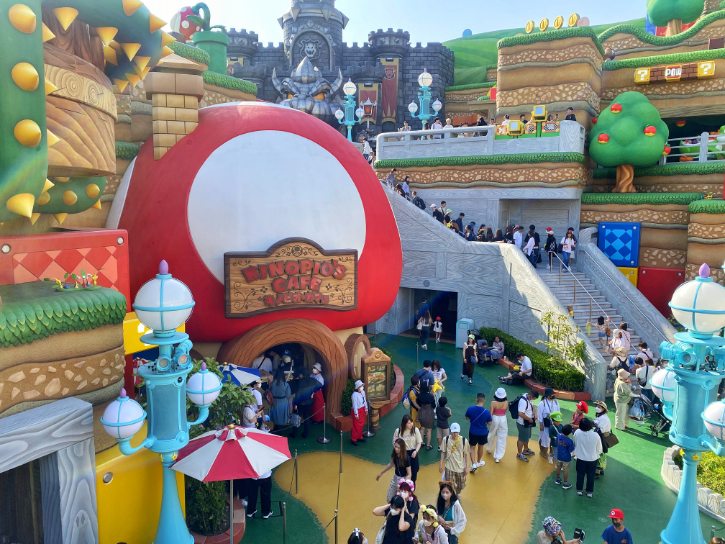
- What They Sell: Mario-themed burgers, pizzas, and desserts.
- Must-Try Dishes: Mario’s Bacon Cheeseburger, Princess Peach’s Cake (good for sharing).
- Budget: ¥2,000–¥3,000 per person.
2. Three Broomsticks (Wizarding World of Harry Potter)
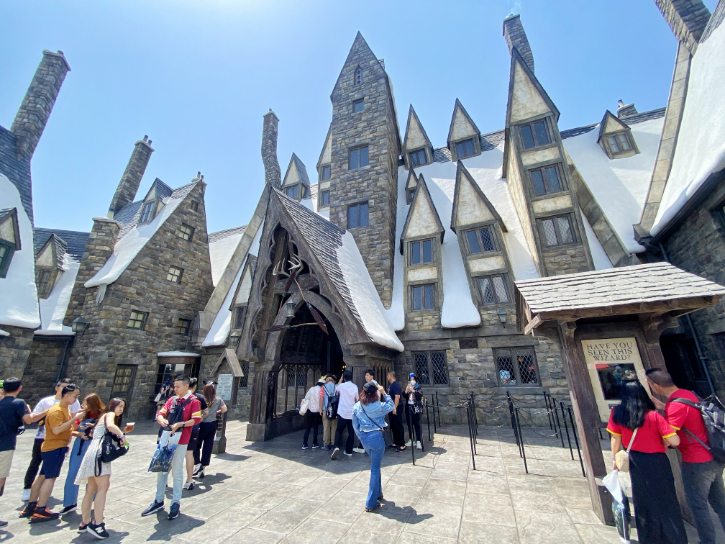
- What They Sell: British pub dishes like fish & chips and shepherd’s pie.
- Must-Try Dishes: Fish & Chips, Shepherd’s Pie, Butterbeer.
- Budget: ¥2,000–¥3,500 per person.
3. Happiness Cafe (Minion Park)
- What They Sell: Minion-themed burgers, curry omelette rice, snacks.
- Must-Try Dishes: Minion Curry Omurice, Minion Burger Set (includes unlimited drink refills).
- Budget: ¥1,800–¥2,200 per person.
4. Mel’s Drive-In (Hollywood Area)
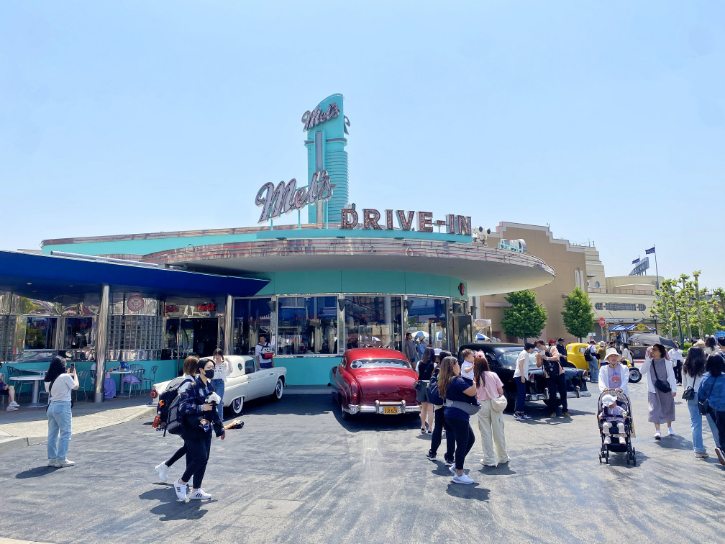
- What They Sell: Classic American burgers, fries, hot dogs, milkshakes.
- Must-Try Dishes: BBQ Bacon Cheeseburger, Classic Cheeseburger
- Budget: ¥1,700–¥2,000 per person.
f. How to Get to Universal Studios Japan from Osaka Station
Take the Osaka Loop Line/ EXPO Liner from Osaka Station to Universal-City Station for ¥190 in 6 minutes, then walk 5 minutes to Universal Studios Japan.
Read More: 3 Best Ways to Get to Universal Studios Japan
Day 4: Osaka to Kyoto
10:00 AM: Getting to Kyoto from Osaka

- At Osaka Station, board the JR Kyoto Line’s Special Rapid Service (also called the Tokaido-Sanyo Main Line) bound for Kyoto.
- This train makes limited stops, including Shin-Osaka, Takatsuki, and Kyoto.
- Stay on the train until you reach Kyoto Station.
- The journey takes about 29 minutes and costs ¥580.
Why Choose the JR Kyoto Line (Tokaido-Sanyo Main Line)
- Direct Access: Provides a direct connection from central Osaka (Osaka Station) to Kyoto Station without any transfers.
- Train Type: Opt for the “Special Rapid Service” trains, as these offer the quickest travel times.
- Journey Duration: The ride lasts about 29 minutes.
- Stops: The train only stops at Osaka, Shin-Osaka, Takatsuki, and Kyoto.
- Affordability: A one-way ticket costs just ¥580, offering excellent value.
- Frequency: Trains depart every few minutes, ensuring minimal waiting time.
Read More: Osaka to Kyoto: The Best Transport Options
10:30 AM: Hotel Check-in near Kyoto Station
a. Recommended Hotels
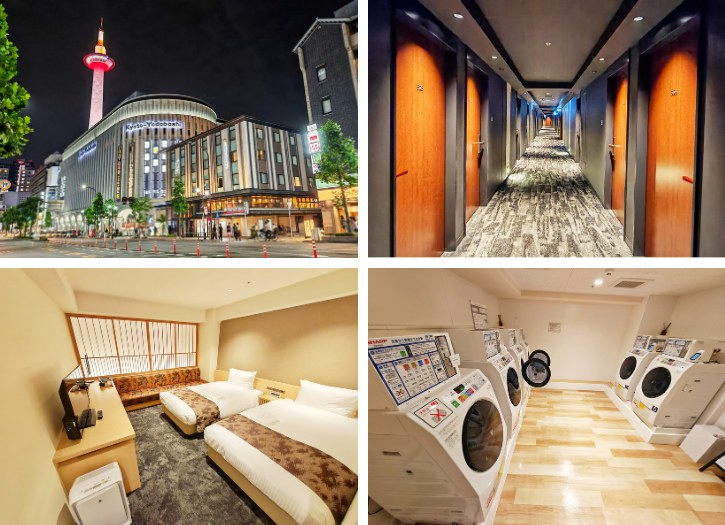
- Daiwa Roynet Hotel Kyoto Ekimae PREMIER (Agoda | Booking.com)
- Location & Transport:
- 3–4 minutes’ walk from JR Kyoto Station’s Central Exit—great if carrying luggage.
- Easy access from Kansai International Airport:
- JR Haruka Express train (about 75 minutes)
- Airport bus (around 90 minutes)
- Taxi stand located right next to the hotel, convenient for short rides or late returns.
- Convenience:
- 24-hour coin laundry machines (automatic detergent provided) for refreshing clothes anytime.
- FamilyMart convenience store within a 2-minute walk; Lawson also nearby.
- Personal Experience:
- I’ve stayed here myself; very comfortable and an excellent base for exploring Kyoto.
- Location & Transport:
- Richmond Hotel Premier Kyoto Ekimae (Agoda | Booking.com): Offers modern amenities and is conveniently located near Kyoto Station, providing easy access to transportation and city attractions.
- Hotel Hokke Club Kyoto (Agoda | Booking.com): Located directly opposite Kyoto Station, ideal for convenient transportation access.
- TUNE STAY KYOTO (Agoda | Booking.com): Located just a 7-minute walk from Kyoto Station, offering easy yet quiet accessibility.
Read More: 5 Incredible Hotels in Osaka & Kyoto You Need to Know About
b. Why Stay Near Kyoto Station?
- Easy Access to Kansai Airport: Direct Haruka Express trains make traveling to and from Kansai Airport effortless.
- Direct Trains to Osaka and Tokyo: Quickly and conveniently reach major cities via Shinkansen (bullet train) services to Tokyo and JR Kyoto Special Rapid Service trains to Osaka.
- Convenient Bus Services: Kyoto Station Bus Terminal provides extensive local bus connections, making it easy to explore popular Kyoto attractions.
Read More: Only 2 Best Places to Stay in Kyoto
11:30 AM: Arashiyama Bamboo Forest
a. Overview

- What It Is: A natural bamboo grove in Kyoto’s Arashiyama district with pathways surrounded by towering bamboo stalks.
- History: Centuries-old grove valued in Japanese culture for construction, crafts, and cuisine.
- Why Visit: Calming experience with filtered sunlight, gentle rustling sounds, and perfect for photography.
- Atmosphere: Peaceful retreat with a natural bamboo canopy, winding paths, and tranquil environment.
- Best For: Anyone wanting a short 15-20 minute nature walk, photography enthusiasts, nature lovers, or travelers exploring nearby attractions like Togetsukyo Bridge and Tenryu-ji Temple.
b. Exploring the Bamboo Grove
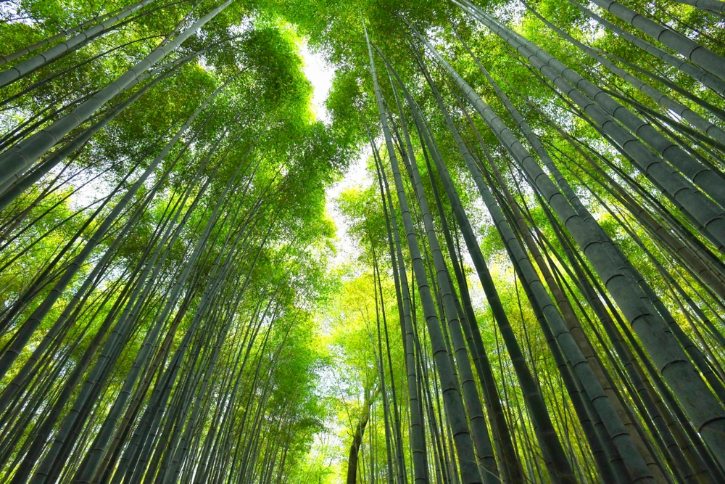
- Short Walk: The main path is short, only around 300 meters.
- Look Up: Make sure you look up to see how tall the bamboo really is.
- Listen Closely: Pause for a moment to hear the gentle sound of bamboo leaves moving in the wind.
- Take Your Time: Slow down, relax, and enjoy the calm atmosphere, even if it gets a bit crowded.
c. How to Get to Arashiyama Bamboo Forest from Kyoto Station
Take the JR San-In Line from Kyoto Station to Saga-Arashiyama Station for ¥240 in 18 minutes, then walk 10 minutes to Arashiyama Bamboo Forest.
12:00 PM: Tenryuji Temple
a. Overview
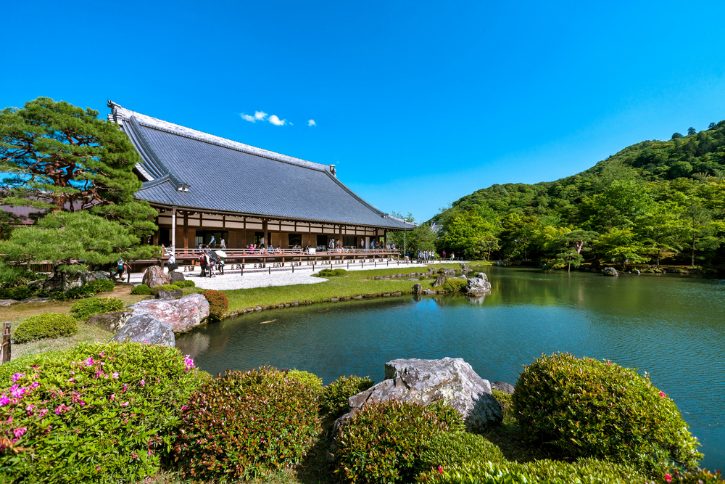
- What It Is: UNESCO World Heritage Site and major Zen Buddhist temple in Kyoto, famous for its garden and historic architecture.
- History: Founded in 1339 by Shogun Ashikaga Takauji; rebuilt multiple times after fires; current structures mostly from Meiji Period.
- Why Visit: Experience Muso Soseki’s stunning garden with mountain views; enjoy authentic Zen aesthetics away from Kyoto’s crowds.
- Atmosphere: Peaceful environment for connecting with nature and Zen culture; especially beautiful during seasonal changes.
- Best For: You’ll love this if you’re into Japanese history, Zen Buddhism, or gardens; perfect for photography, especially during spring blooms and fall foliage.
b. Must-See Highlights
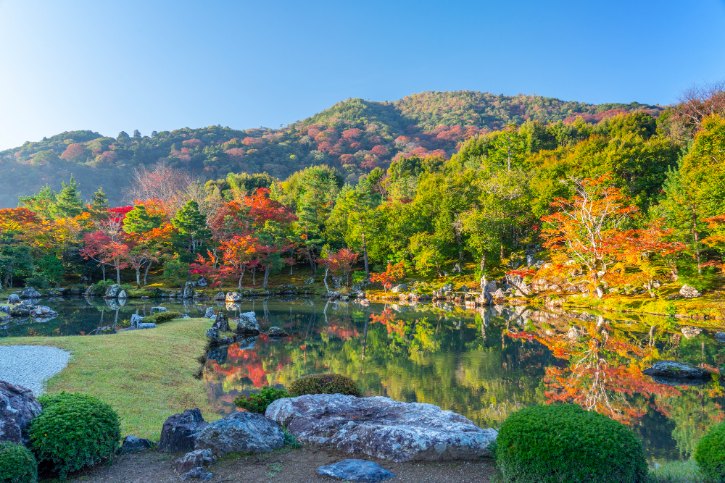
- Sogenchi Garden: Enjoy a peaceful walk through this garden designed by Muso Soseki. You’ll find a calm pond right in the middle.
- Hojo Visit: Step inside the Hojo building to see its lovely architecture and scenic garden views.
- Hatto Hall: Be sure to look up and admire the striking dragon painting on the ceiling.
c. How to Get to Tenryuji Temple from Arashiyama Bamboo Forest
It’s a 3-minute walk from Arashiyama Bamboo Forest to Tenryuji Temple.
1:30 PM: Arashiyama Yoshimura (Lunch)
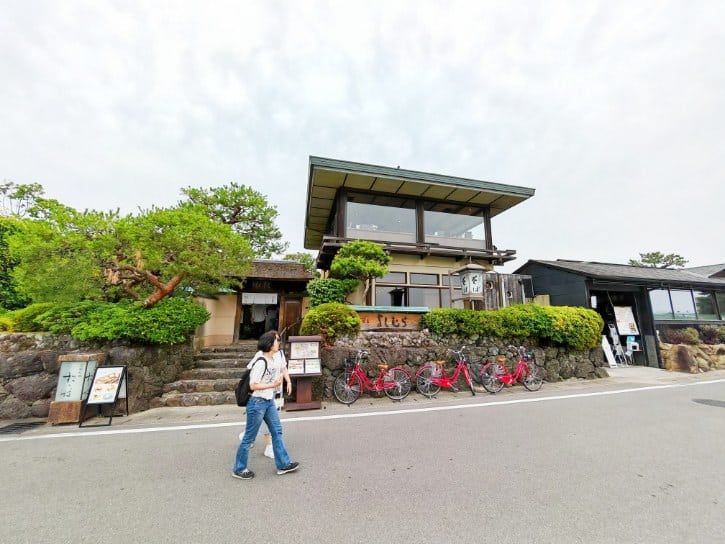
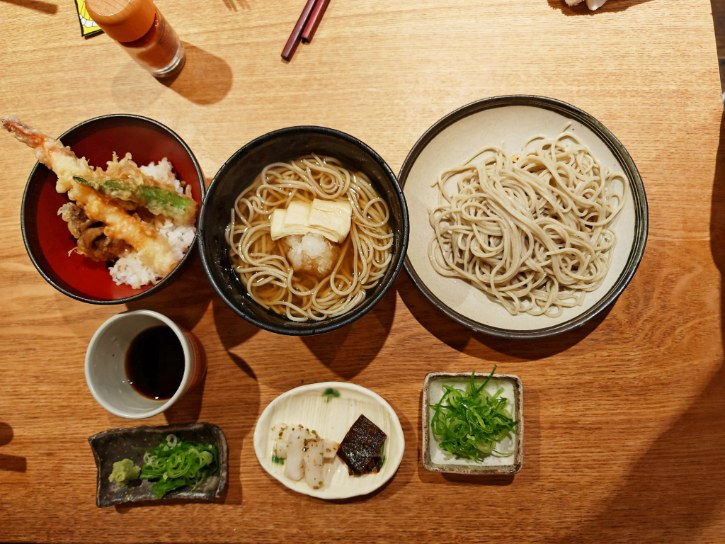
- What They Sell: Handmade fresh soba noodles served hot or cold, prepared daily in-house.
- Must-Try Dishes:
- Togetsuzen Set: Enjoy two types of soba (Zaru and Yuba Oroshi), served either hot or cold, accompanied by a small bowl of crispy tempura rice and flavorful soba koji pickles.
- Soba Tea Roll: Mini sponge cake roll flavored with fragrant roasted soba tea and filled with smooth cream made from fresh Hokkaido milk.
- Budget: Expect to spend around ¥1,800–¥3,000 per person.
How to Get to Arashiyama Yoshimura from Tenryuji Temple
It’s a 5-minute walk from Tenryuji Temple to Arashiyama Yoshimura.
2:30 PM: Togetsukyo Bridge
a. Overview
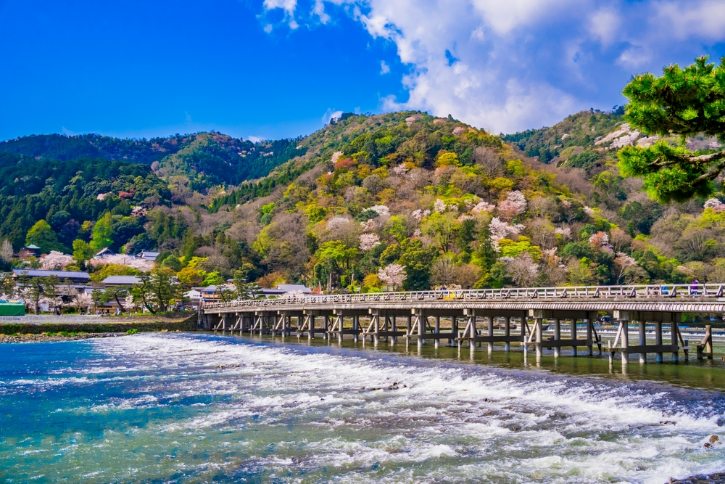
- What It Is: 155-meter “Moon Crossing Bridge” spanning Katsura River in Kyoto’s Arashiyama district; reinforced concrete structure with cypress wood railings.
- History: First built during Heian Period (794-1185); reconstructed multiple times after floods; named by Emperor Kameyama after seeing the moon appear to cross the bridge.
- Why Visit: Experience stunning river and mountain views that change with the seasons; enjoy cherry blossoms in spring and vibrant fall colors in autumn.
- Atmosphere: Serene, picturesque setting with Arashiyama Mountain backdrop; offers tranquil escape from Kyoto’s busy districts while showcasing seasonal beauty.
- Best For: You’ll love this if you enjoy photography, nature walks, or peaceful scenery; perfect for families and couples with nearby cafes and shops for breaks.
b. Things to Do
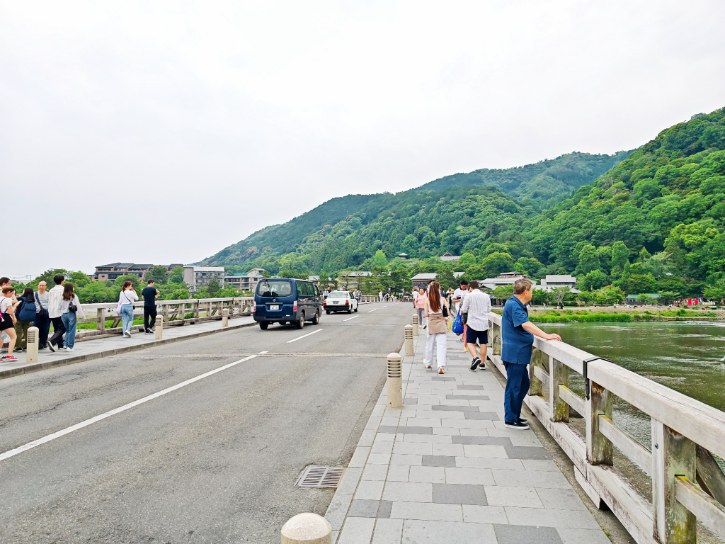
- Enjoy the Scenic Views: Walk across the 155-meter bridge to admire the Katsura River and Arashiyama Mountain. The scenery is especially stunning during cherry blossom season in spring and autumn foliage in fall.
- Visit Local Shops and Eateries: Many souvenir shops and restaurants surround the bridge area; enjoy local snacks while shopping for unique gifts.
- Experience Seasonal Events: If you visit in summer, you might witness traditional cormorant fishing on the river. This unique practice offers insight into local customs.
c. How to Get to Togetsukyo Bridge from Arashiyama Yoshimura
It’s a 1-minute walk from Arashiyama Yoshimura to Togetsukyo Bridge.
3:00 PM: Kimono Forest
a. Overview

- What It Is: Art installation at Randen Arashiyama Station with transparent pillars filled with kimono fabrics; illuminated at night for stunning photos.
- History: Created in 2013 by Yasumichi Morita; blends traditional kimono patterns with modern art to celebrate Kyoto’s heritage.
- Why Visit: Unique combination of traditional textile art and modern design; excellent photography spot, especially after dark.
- Atmosphere: Vibrant patterns by day; magical illumination by night; features Dragon Pond with reflective pool and sculpture.
- Best For: You’ll enjoy this if you love art, photography, or quick cultural experiences; easily accessible for all visitors.
b. Tips for Exploring Kimono Forest

- Explore the Kimono Pillars: Wander through the station area to admire the colorful kimono patterns displayed on the transparent pillars.
- Visit the Dragon Pond: Find the Dragon Pond at the end of the pathway featuring a black stone sphere with a golden dragon engraving; making a wish here is said to bring good fortune.
- Relax at the Footbath: Soak your tired feet in the station’s footbath (ashiyu) for a comfortable break during your visit.
c. How to Get to Kimono Forest from Togetsukyo Bridge
It’s a 3-minute walk from Togetsukyo Bridge to Kimono Forest.
4:00 PM: Fushimi Inari Taisha
a. Overview
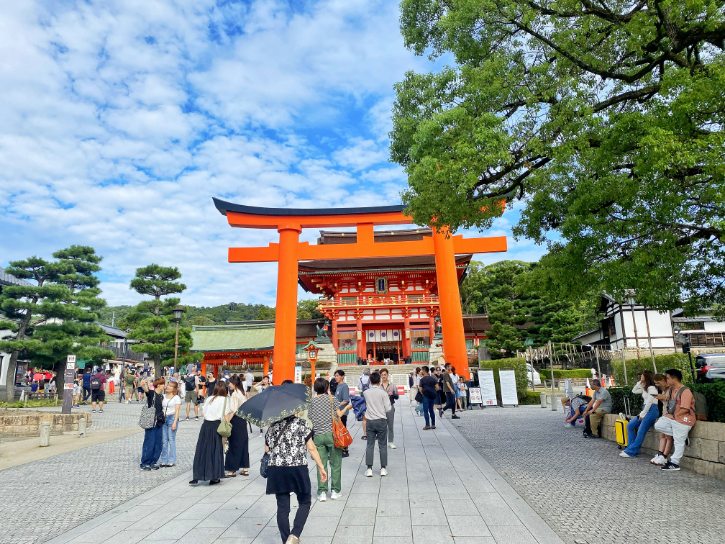
- What It Is: Famous Shinto shrine in Kyoto dedicated to Inari, god of rice and prosperity; renowned for thousands of bright orange torii gates forming a path up Mount Inari.
- History: Founded in 711, one of Kyoto’s oldest shrines; dedicated to Inari, protector of rice and prosperity; businesses have donated torii gates over time, creating the iconic tunnels seen today.
- Why Visit: Free entry and open 24/7; unique torii gate tunnels create stunning photo opportunities, especially in early morning or late afternoon light.
- Atmosphere: Serene, spiritual environment; crowds thin out as you ascend the mountain; fox statues (Inari’s messengers) add to the mystical feel.
- Best For: You’ll enjoy this if you’re interested in Japanese culture, photography, and nature walks; full hike takes about two hours round-trip with scenic views and exercise.
b. What to Do and See
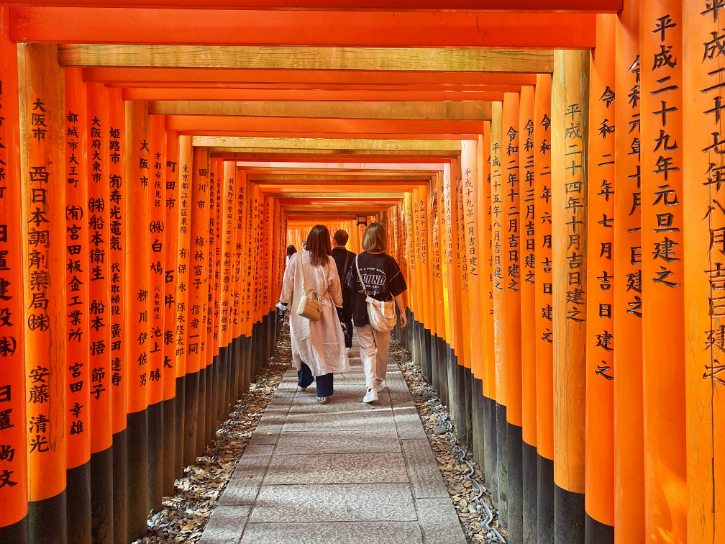
- Start at the Romon Gate: Begin at the impressive red gate donated by Toyotomi Hideyoshi; perfect photo spot and entrance to the main shrine area.
- Explore the Main Shrine: Visit the main shrine buildings; offer prayers and learn about Inari, the god of rice and business.
- Walk the Torii Gates: Experience the iconic red torii gates by staying to the right to avoid bumping into others; even a short walk gives you a great experience without hiking the entire trail.
- Explore Side Trails: Discover quieter side paths leading to smaller shrines for a peaceful rest; look for fox statues (Inari’s messengers) and stone lanterns along the way.
Read More: Visiting Fushimi Inari Shrine in Kyoto: Your Complete Guide
c. How to Get to Fushimi Inari Taisha from Kimono Forest
Take the JR San-In Line from Saga-Arashiyama Station to Kyoto Station, then transfer to the JR Nara Line to Inari Station. The total trip takes about 25 minutes and costs ¥240. From Inari Station, it’s a 1-minute walk to Fushimi Inari Taisha.
7:00 PM: Dinner near or at Kyoto Station
a. Honke Daiichi-Asahi
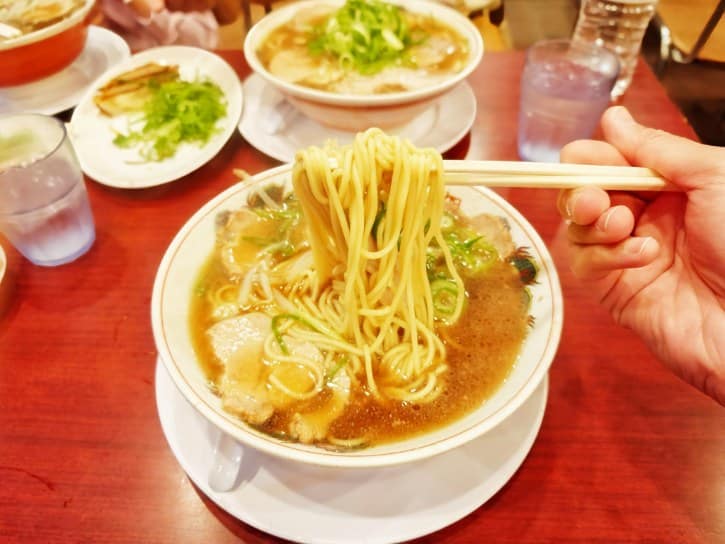
- What They Sell: Kyoto-style ramen with soy-based pork broth, tender pork slices and green onions. Known for tasty and filling ramen bowls.
- Must-Try Dishes:
- Tokusei Ramen (Special Ramen): Double portion of pork and noodles – perfect if you’re hungry.
- Gyoza (Dumplings): Crispy pork-and-veggie dumplings; great side dish.
- Budget: Affordable; regular ramen is ¥980, special ramen is ¥1,180, gyoza is ¥320. Expect ¥1,000–¥1,500 per person.
b. Sushi no Musashi
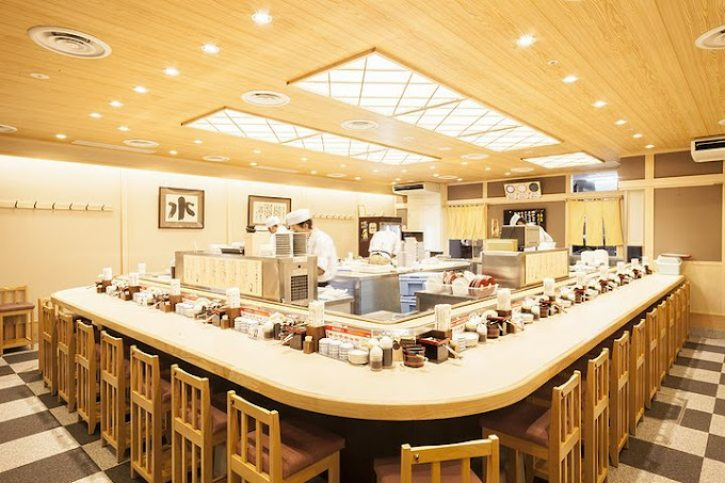
- What They Sell: Conveyor-belt sushi with around 50 sushi types—fresh, affordable, casual atmosphere.
- Must-Try Dishes:
- Classic Nigiri: Tuna, Grilled Salmon Belly, and Grilled Eel.
- Chutoro (Fatty Tuna): Rich, buttery tuna at a great taste.
- Tamago (Egg Omelette): Sweet and fluffy, nice palate cleanser.
- Budget: Most sushi plates cost ¥160, premium plates ¥400. Typical spending is ¥1,000–¥2,000 per person.
c. Katsukura – Kyoto Porta
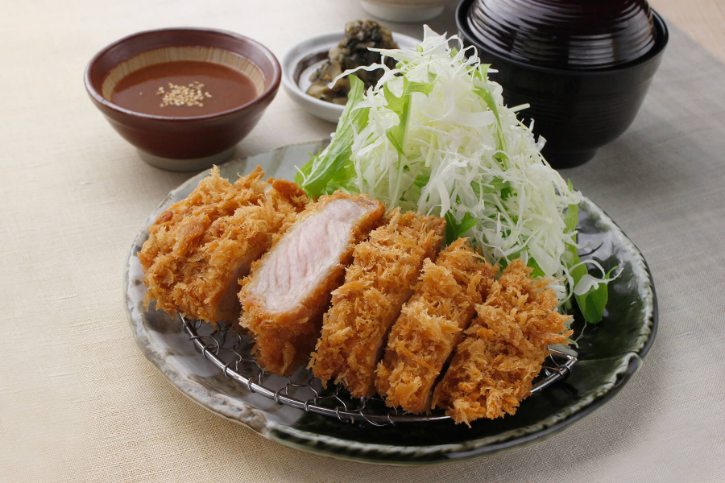
- What They Sell: Tonkatsu (breaded, fried pork cutlets) served as set meals with rice, cabbage, and miso soup.
- Must-Try Dishes:
- Pork Loin Set (Kinkaton Rosu): Juicy pork with a bit of fat, very flavorful.
- Pork Fillet Set (Oebi to Hire Katsu): Large prawn cutlet and pork tenderloin cutlet
- Budget: Moderate pricing; standard sets cost ¥1,700–¥1,800. Combo or premium sets ¥2,000–¥3,000. Meals include free refills of rice, miso soup, and cabbage when you order a set meal.
How to Get to the Restaurants Above from Fushimi Inari Taisha
Take the JR Nara Line from Inari Station to Kyoto Station for ¥150 in 7 minutes.
Day 5: Kiyomizudera Temple, Sannenzaka, Yasaka Shrine and Kyoto Gion
9:30 AM: Kiyomizudera Temple
a. Overview
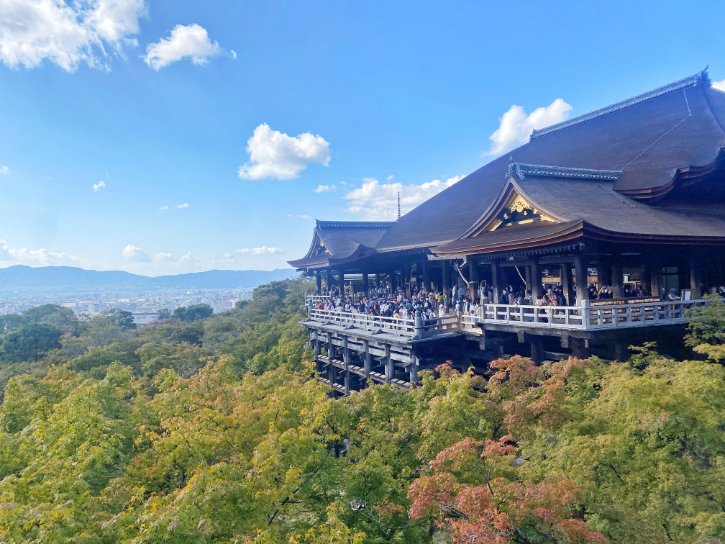
- What It Is: Historic Buddhist temple in Kyoto with wooden stage jutting over hillside; UNESCO site with stunning city views.
- History: Founded in 778; current buildings from 17th century; dedicated to Kannon, goddess of mercy; part of Higashiyama cultural zone.
- Why Visit: Combines spiritual, historical, and natural beauty; famous wooden stage built without nails; spectacular during cherry blossom and autumn foliage seasons.
- Atmosphere: Serene setting with Otowa Waterfall; surrounded by traditional Higashiyama streets with shops and tea houses.
- Best For: You’ll enjoy this if you love photography and history; don’t miss drinking from the sacred waterfall said to grant wisdom, health, or longevity.
b. Temple Spots You’ll Love Exploring
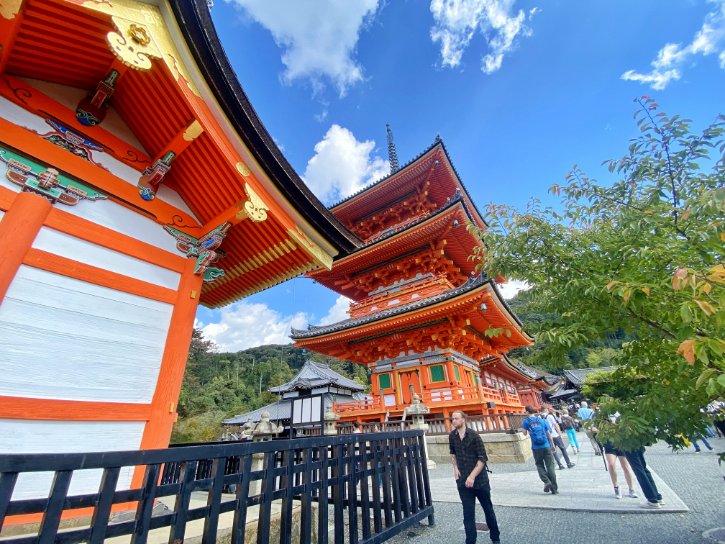
- Explore the Main Hall and Stage: Visit the wooden stage for panoramic Kyoto views; best for photos during cherry blossoms and autumn colors.
- Three-Storied Pagoda: Photograph one of Japan’s tallest pagoda (31 meters) with its striking vermillion color against Kyoto’s skyline.
- Otowa Waterfall: Drink from one sacred stream for longevity, academic success, or love; choosing all three is considered greedy.
c. How to Get to Kiyomizudera Temple from Kyoto Station
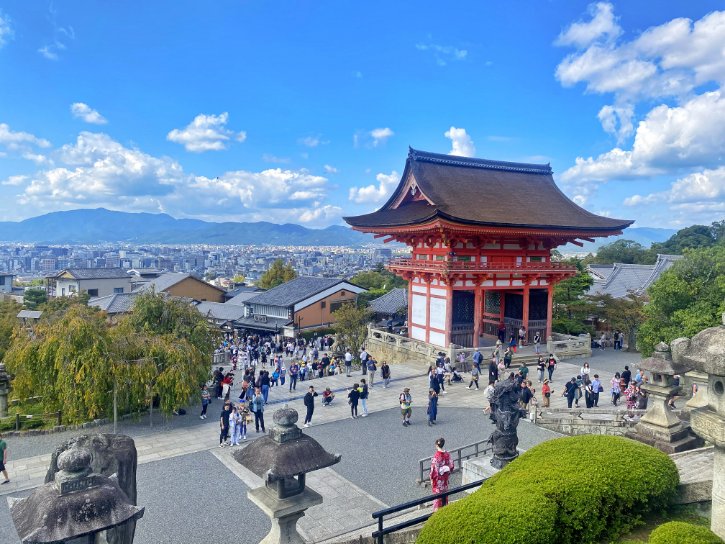
Take Kyoto City Bus 206 from Kyoto Station to Kiyomizumichi bus stop for ¥230 (16 minutes), then walk 10 minutes to Kiyomizu-dera.
11:30 AM: Sannenzaka
a. Overview
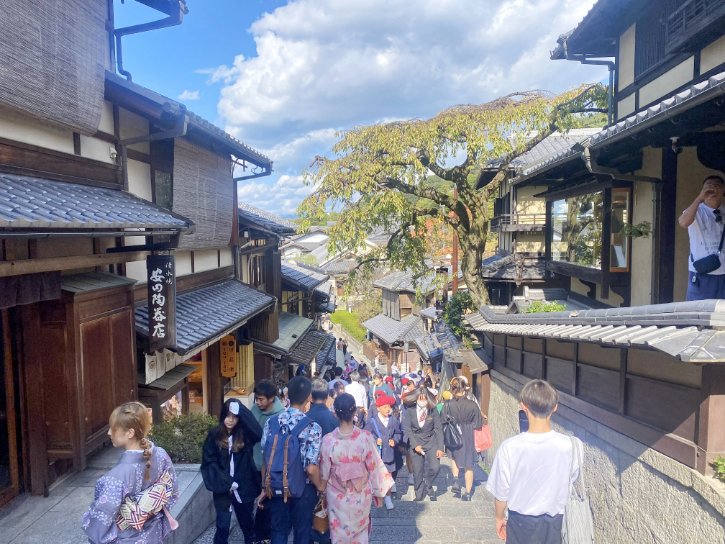
- What It Is: Historic sloping street in Kyoto’s Higashiyama district; traditional wooden buildings and shops offering a glimpse of old Kyoto.
- History: Over 1,000 years old; originally a pathway to Kiyomizu-dera Temple; named “Three-Year Slope” because legend says if you fall here, misfortune will follow you for three years (just a myth!).
- Why Visit: Experience traditional Kyoto charm; find unique souvenirs and local matcha sweets; capture stunning photos of cobblestone paths and lantern-lit alleys.
- Atmosphere: Feels like stepping back in time; bustling but not overwhelming; mix of locals and tourists; early mornings or late afternoons offer more serene experiences.
- Best For: You’ll love this for experiencing Kyoto culture; handicraft shopping; perfect when visiting nearby Kiyomizu-dera Temple.
b. Best Places to Savor Local Delicacies
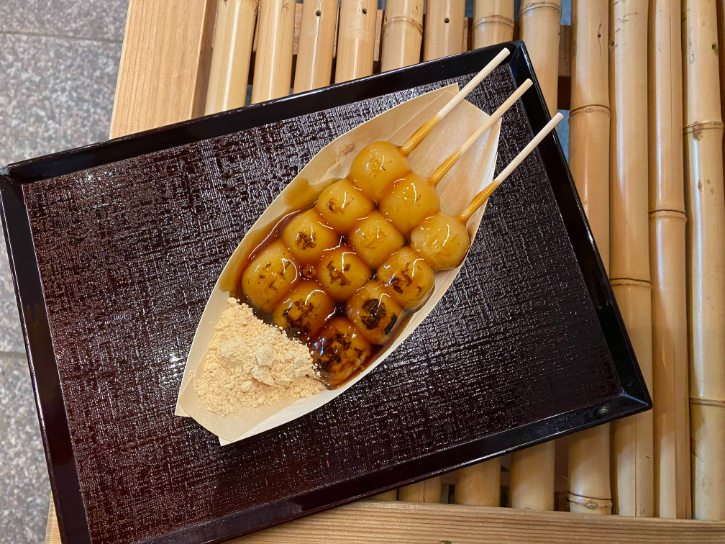
- Fujinami: Offers traditional Kyoto flavors, famous for iced matcha and popular soy sauce-flavored dango.
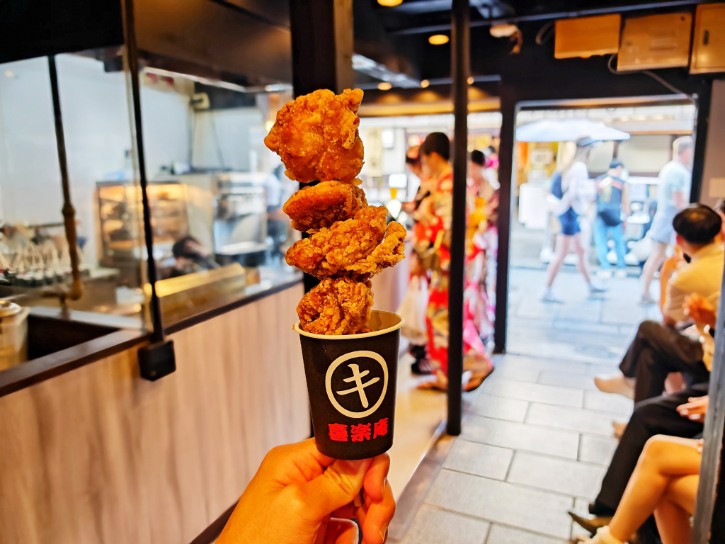
- Kirakuan Okamoto Sanneizaka: Known for “Maiko-yaki”, geisha apprentice-shaped snacks in red bean, cream, matcha, and ham & cheese varieties. Also popular for their croquettes.
- Okutan Kiyomizu: Specializes in handmade tofu dishes, notably soy milk and black honey shaved ice, praised for its rich, homemade soy milk taste.
- Ukiya Kiyomizu Kiseian: Renowned for handmade soba noodles, but their exceptional oyakodon (particularly fried shrimp) stands out with crispy batter and tender shrimp.
- Umezono Kiyomizu: Established in 1927, serves classic Japanese sweets such as matcha, shiratama zenzai (mochi in red bean soup), warabi mochi, and seasonal treats.
c. How to Get to Sannenzaka from Kiyomizudera Temple
It’s a 3-minute walk from Kiyomizudera Temple to Sannenzaka.
12:30 PM: Yasaka Pagoda
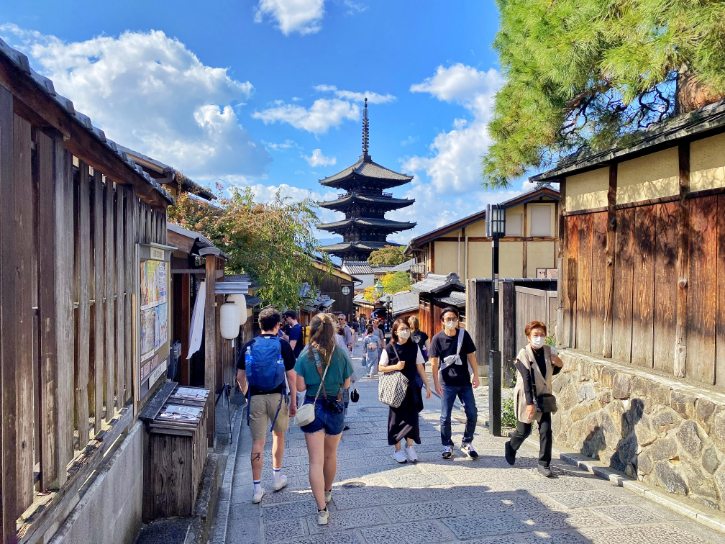
- What It Is: Historic five-story pagoda (Hokan-ji Temple) in Kyoto’s Higashiyama district; iconic landmark frequently featured in photos and postcards.
- History: Over 1,400 years old, dating back to 6th century; originally part of larger temple complex that no longer exists; rebuilt several times due to fires while maintaining classic design.
- Why Visit: One of Kyoto’s most photographed scenes; perfect silhouette against traditional streets.
- Atmosphere: Peaceful and timeless; soft chime of wind bells; especially magical during early mornings or evenings when crowds thin out.
- Best For: You’ll love this if you’re a history enthusiast, architecture lover, or photographer; perfectly situated between Kiyomizu-dera Temple and Yasaka Shrine for easy sightseeing.
c. How to Get to Yasaka Pagoda from Sannenzaka
It’s a 3-minute walk from Sannenzaka to Yasaka Pagoda.
12:40 PM: Ninenzaka
a. Overview

- What It Is: Charming historic pedestrian street in Kyoto; traditional wooden machiya houses and stone-paved paths creating old-world atmosphere.
- History: Dates back to Edo period (1603-1868); originally a pilgrimage route to Kiyomizu-dera; named “Two-Year Hill” from superstition that falling here brings two years of bad luck.
- Why Visit: Experience traditional Japanese architecture; shop for local crafts; enjoy authentic Kyoto cuisine.
- Atmosphere: Nostalgic charm with preserved buildings; no modern intrusions like power lines; picturesque spot for leisurely walks.
- Best For: You’ll love this for exploring Kyoto’s history; perfect for photos and local treats like matcha ice cream or yatsuhashi; ideal before or after visiting Kiyomizu-dera.
b. Top Food Spots to Explore
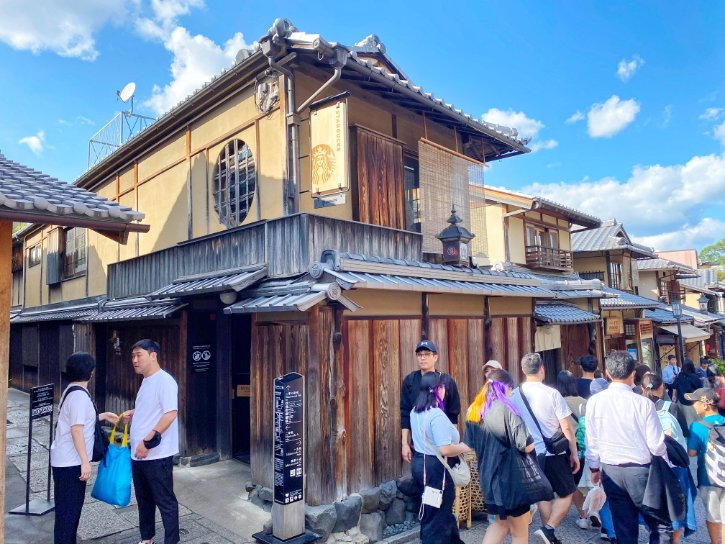
- Starbucks Kyoto Nineizaka Yasaka Chaya: A distinctive Starbucks with tatami-style seating, seamlessly combining contemporary coffee culture with a traditional Japanese ambiance.
- Ishidatami: Renowned for premium soft-serve ice cream, especially their indulgent matcha flavor prepared using a homemade sauce.
- Fujinami Kodai-ji Temple Store: Known for authentic Kyoto-style sweets, specializing in handcrafted dango and mochi made with high-quality ingredients.
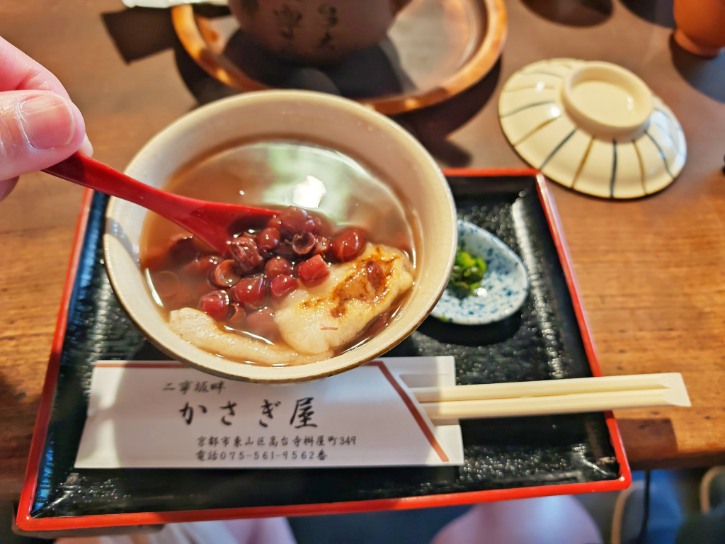
- Kasagiya: A historic sweet shop evoking the Taisho era, famed for classic treats like o-hagi (rice cakes) and zenzai (sweet bean soup).
c. How to Get to Ninenzaka from Yasaka Pagoda
It’s a 2-minute walk from Yasaka Pagoda to Ninenzaka.
1:40 PM: Lunch in Kyoto Gion
a. Hisago
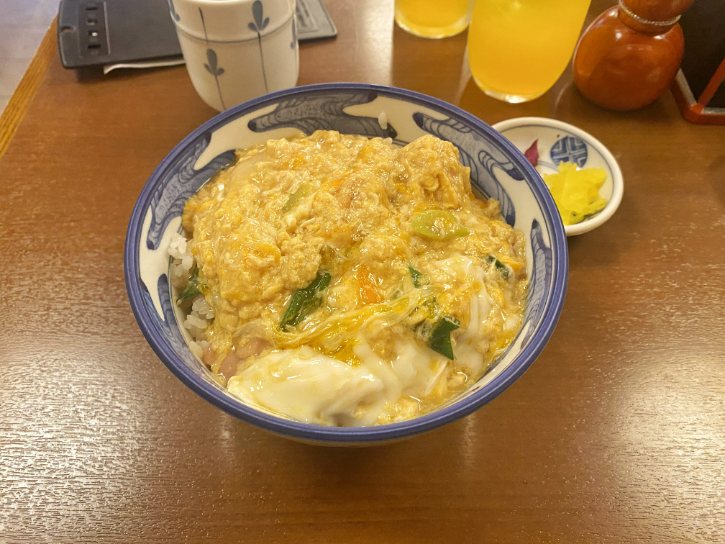
- What They Sell: Traditional Japanese rice bowls (donburi) and noodle dishes.
- Must-Try Dishes: Oyakodon (chicken and egg rice bowl), Nishin Soba (noodles with simmered herring), Kitsune Udon (noodles with fried tofu).
- Budget: Budget-friendly; around ¥1,000 per dish, usually under ¥2,000 per person.
b. Gyukatsu Kyoto Katsugyu – Gion Yasaka
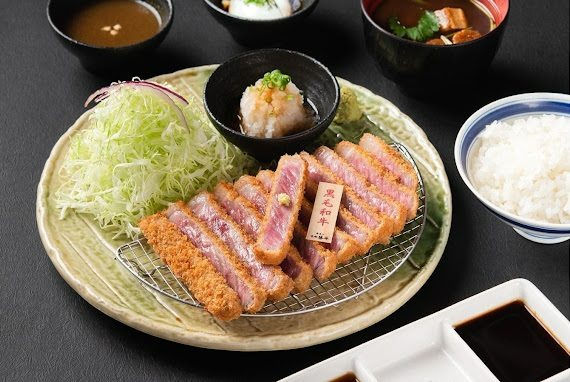
- What They Sell: Gyukatsu (deep-fried beef cutlets served medium-rare).
- Must-Try Dishes: Sirloin Gyukatsu Zen set with premium beef.
- Budget: Around ¥2,000–¥3,000 per person.
How to Get to the Restaurants Above from Ninenzaka
It’s just a 2 to 10-minute walk from Ninenzaka to the restaurants listed above.
2:40 PM: Yasaka Shrine
a. Overview
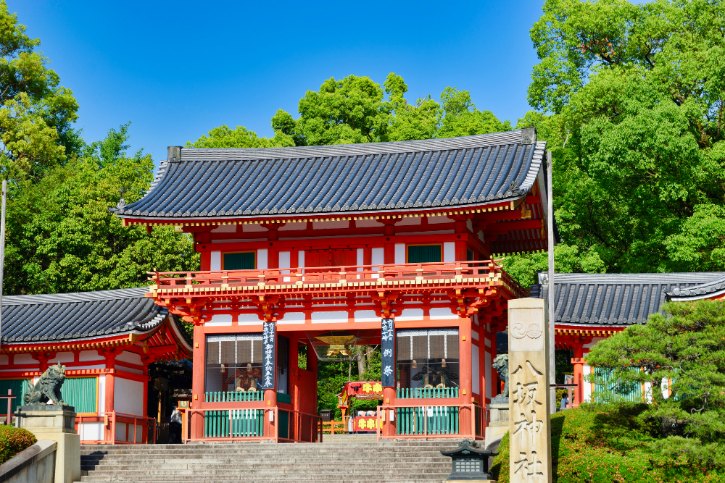
- What It Is: Famous historic Shinto shrine in Kyoto (also called Gion Shrine); vibrant spiritual and cultural hub dedicated to Susanoo-no-Mikoto, deity of protection from illnesses.
- History: Over 1,350 years old; closely tied to Gion Matsuri festival, held annually since 869 AD to pray for protection against plagues.
- Why Visit: Striking vermilion gate and main hall adorned with numerous lanterns; especially picturesque at night.
- Atmosphere: Lively yet peaceful; locals praying, tourists exploring; lanterns lit at night creating magical setting; particularly enchanting during cherry blossom season in Maruyama Park.
- Best For: You’ll love this for its blend of history, culture, and accessibility; visit in July to experience the Gion Matsuri festival where the shrine plays a central role.
b. Must-visit Spots
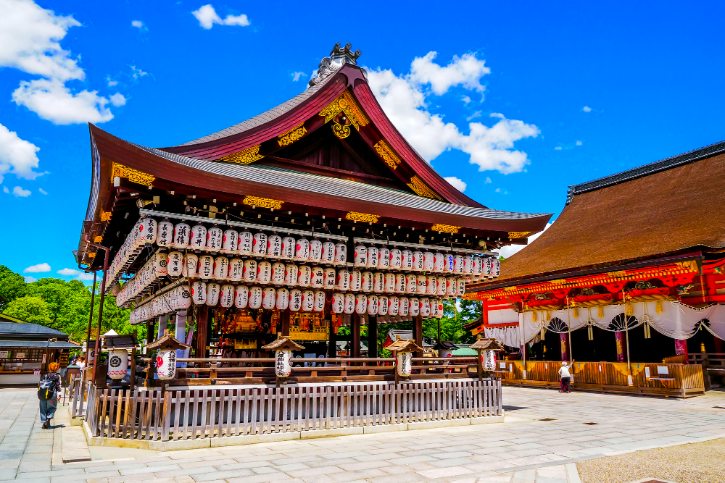
- Main Hall (Honden): Heart of the shrine for paying respects; beautiful traditional architecture; participate in simple ritual: toss coin, bow twice, clap twice, make wish, bow once more.
- Dance Stage (Kagura-den): Located in front of main hall; adorned with hundreds of lanterns lit in evenings; each lantern bears name of donating local business; used for traditional festival performances.
- Vermilion Entrance Gate (Nishiromon): Iconic red gate marking western entrance; popular photo spot; serves as landmark in Gion district.
- Maruyama Park: Peaceful park adjacent to shrine; especially stunning during cherry blossom season (late March to early April); plenty of relaxation spots.
- Beauty & Matchmaking Spots: Splash “beauty water” at Utsukushii Gozen Shrine for inner/outer glow; write wishes on heart-shaped plaques at Okuninushi Shrine for love luck.
How to Get to Yasaka Shrine from the Restaurants Above
It’s a 5-minute walk from the restaurants above to Yasaka Shrine.
4:00 PM: Hanamikoji Street
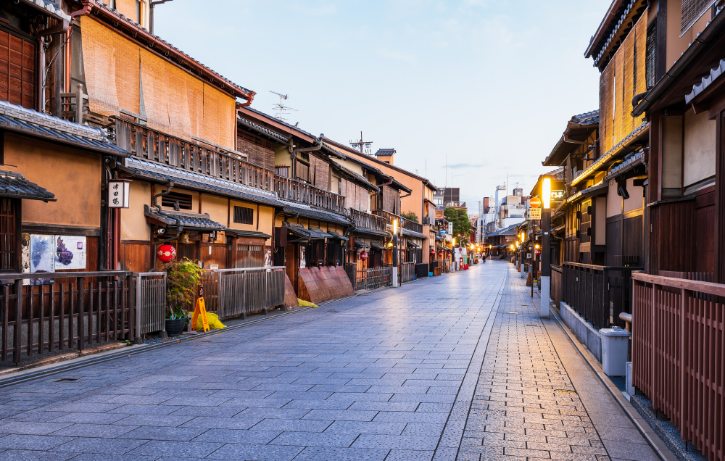
- What It Is: Charming historic street in Kyoto’s Gion district; traditional wooden machiya houses, tea houses, and geisha culture; one of the most picturesque and well-preserved areas in Kyoto.
- History: Dates back to Edo period (1603-1868); long associated with geiko (Kyoto’s geisha) and maiko (apprentice geisha); traditional entertainment hub where tea houses hosted performances.
- Why Visit: Experience Kyoto’s traditional atmosphere; stroll past preserved buildings; opportunity to spot geiko or maiko in elegant kimonos; authentic tea houses and restaurants.
- Atmosphere: Refined ambiance; stone-paved paths lined with traditional wooden buildings; lanterns illuminate the area in evening, enhancing historic charm.
- Best For: You’ll love this for experiencing Kyoto’s traditional side; perfect for photography and cultural exploration; chance to glimpse geiko or maiko heading to appointments.
How to Get to Hanamikoji Street from Yasaka Shrine
It’s a 5-minute walk from Yasaka Shrine to Hanamikoji Street.
5:00 PM: Saryo Tsujiri Tea House (Gion Main Store)
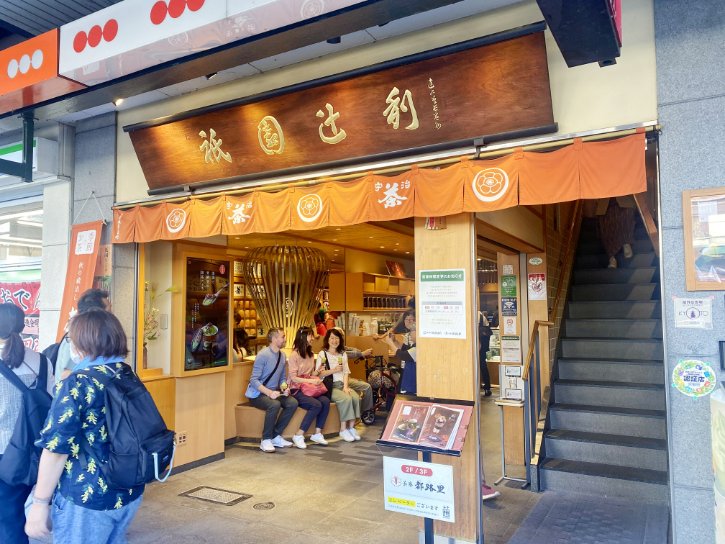
- What It Is: Well-known café in Kyoto’s Gion district; specializes in Uji tea and matcha-flavored desserts.
- History: Established in 1948; long-standing tradition of offering high-quality Uji tea; Saryo Tsujiri later introduced to serve tea-infused sweets in relaxed setting.
- Why Visit: Authentic Japanese tea culture experience; variety of matcha desserts including popular “Special Tsujiri Parfait” with matcha ice cream, red beans, and mochi; convenient takeout options like matcha soft serve and bottled tea.
- Atmosphere: Cozy traditional Japanese ambiance; perfect for unwinding after exploring busy Gion; interior design reflects Kyoto’s cultural heritage; serene environment.
- Best For: You’ll love this if you’re a matcha enthusiast seeking rich, high-quality Uji tea products; great for cultural immersion in Kyoto’s tea traditions; excellent for souvenir shopping with unique tea sets and snacks.
How to Get to Saryo Tsujiri Tea House from Hanamikoji Street
It’s a 2-minute walk from Hanamikoji Street to Saryo Tsujiri Tea House.
6:00 PM: Teramachi Kyogoku Shopping Street
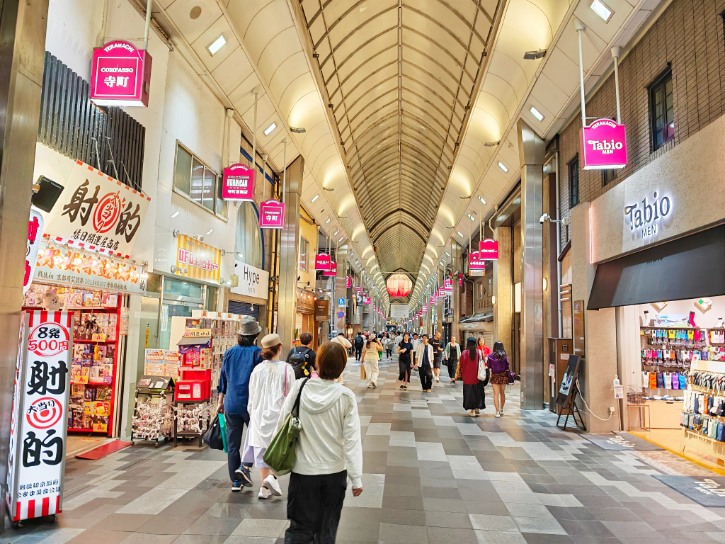
- What It Is: Covered shopping arcade in Kyoto; blend of traditional and modern shops selling souvenirs, clothing, and local foods.
- History: Established in the 16th century by warlord Toyotomi Hideyoshi; named “Temple Town” because Hideyoshi relocated numerous temples to this area.
- Why Visit: Experience Kyoto’s history alongside modern shopping; find handcrafted fans at Hakuchikudo; enjoy local dishes at Kyo Tsuke-men Tsurukame and Moritoshi.
- Atmosphere: Friendly and laid-back; colorful storefronts; popular with locals and tourists; perfect for casual browsing.
- Best For: You’ll love this if you want unique souvenirs like handcrafted fans and want to experience Kyoto’s blend of tradition and modernity.
How to Get to Teramachi Kyogoku Shopping Street from Saryo Tsujiri Tea House
It’s a 10-minute walk from Saryo Tsujiri Tea House to Teramachi Kyogoku Shopping Street.
7:30 PM: Pontocho Alley
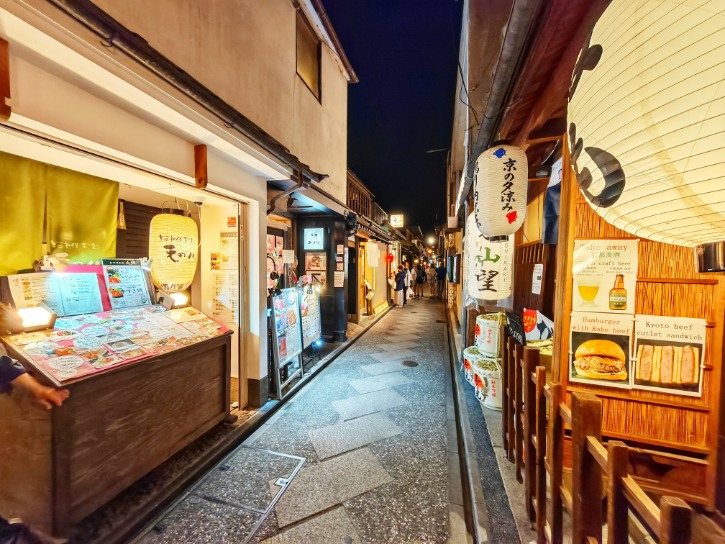
- What It Is: Narrow 500-meter alley in Kyoto; runs parallel to Kamo River; known for traditional wooden teahouses, upscale restaurants, and historic geisha culture.
- History: Established in the 1670s; became an entertainment district with teahouses and geisha establishments; played significant role in Kyoto’s cultural history.
- Why Visit: Glimpse into Kyoto’s rich history; chance to see geisha and maiko in traditional settings; variety of dining options from casual yakitori stands to upscale kaiseki restaurants; many offer riverside seating.
- Atmosphere: Magical lantern-lit streets, especially at night; narrow pathways create intimate feel; favorite spot for evening strolls and photography.
- Best For: You’ll love this if you’re a food lover or photography enthusiast; perfect for romantic dinners and experiencing the historic ambiance of traditional Kyoto.
How to Get to Pontocho Alley from Teramachi Kyogoku Shopping Street
It’s a 5-minute walk from Teramachi Kyogoku Shopping Street to Pontocho Alley.
8:00 PM: Dinner near Pontocho Alley
a. Kappa Sushi

- What They Sell: Fresh sushi, specializing in traditional nigiri (hand-pressed sushi).
- Must-Try Dishes: Rich Southern Bluefin Tuna, Red Sea Bream with citrus, Fresh Yellowtail, Big Shrimp, and Hokkaido Abalone.
- Budget: About ¥1,500 – ¥2,500 per person.
b. Kichi Kichi Omurice
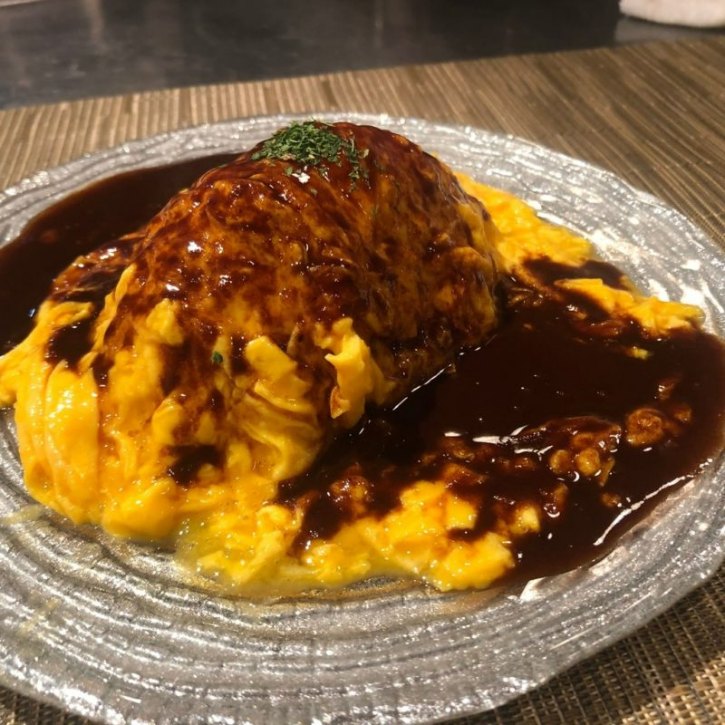
- What They Sell: Famous for Japanese-style omelette rice (omurice) and hearty beef stews.
- Must-Try Dishes: Order the signature Omurice served with rich demi-glace sauce. The beef stew is also highly recommended.
- Budget: Omurice costs around ¥3,000 (full size) or ¥1,600 (half). Beef stew is about ¥3,800.
c. Kyoto Yakiniku Hiro Pontocho

- What They Sell: Japanese-style BBQ (yakiniku) with premium wagyu beef you grill at your table.
- Must-Try Dishes: Try a wagyu beef course menu for the best variety. Popular dishes include the tender “Hana-saki Momo”, seared sirloin, and spicy marinated horumon (beef offal).
- Budget: Expect ¥3,000–¥5,000 per person. Course menus range from ¥6,000–¥10,000.
Day 6: Kinkakuji, Nijo Castle, Nishiki Market, Shijo and Kawaramachi Streets
9:30 AM: Kinkakuji
a. Overview

- What It Is: Zen Buddhist temple in Kyoto; famous for its top two floors covered in gold leaf; reflects beautifully on surrounding pond; UNESCO World Heritage Site; one of Kyoto’s most iconic landmarks.
- History: Originally built in 1397 as a shogun’s retirement villa; later converted into a Zen temple; current structure is a 1955 reconstruction after the original was burned down in 1950.
- Why Visit: Must-see for breathtaking beauty and serene atmosphere; golden reflection on water is unforgettable, especially on sunny days; excellent example of traditional Japanese architecture and Zen garden design.
- Atmosphere: The temple grounds are peaceful and calming, with well-maintained gardens and walking paths. Even with crowds, the layout ensures you can enjoy the views without feeling rushed.
- Best For: You’ll love this if you enjoy history, architecture and nature; perfect for a short visit (30-60 minutes) and capturing memorable photos of Japan’s most iconic temple.
b. Top Things to Do and See
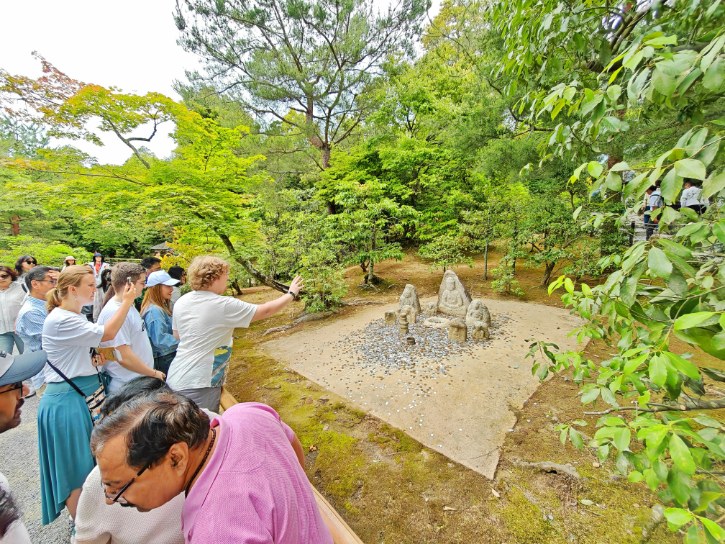
- Coin Tossing for Luck: Find the small statues near the Golden Pavilion; toss coins into the bowl at the statues’ base to make a wish for protection and good fortune.
- Observe the Golden Pavilion’s Reflection: Take time to admire stunning reflection on Kyoko-chi Pond; most beautiful on calm days when water perfectly mirrors the temple.
- Explore the Gardens: Stroll through beautifully landscaped gardens surrounding pavilion; follow path around pond for various viewpoints of temple and its reflection.
- Anmintaku Pond: Visit this tranquil pond that never dries up; features small island dedicated to white snake (water deity symbol); observe five-ringed pagoda Buddhist monument in pond’s center.
c. How to Get to Kinkakuji from Kyoto Station
Take Kyoto City Bus 205 from Kyoto Station to Kinkakuji-michi bus stop for ¥230 (40 minutes), then walk 2 minutes to Kinkakuji.
11:00 AM: Nijo Castle
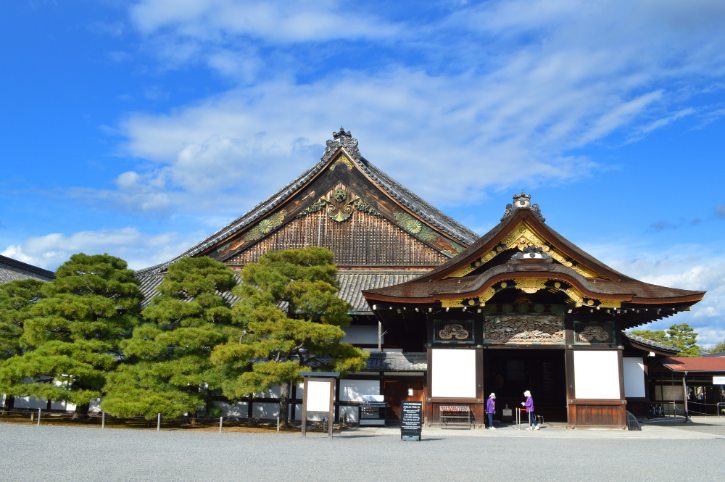
- What It Is: Historic castle in Kyoto built in 1603; residence of the first Tokugawa shogun; UNESCO World Heritage Site.
- History: Served as the Kyoto residence for Tokugawa shoguns; site where the last shogun announced the return of power to the emperor in 1867; marked the end of shogunate rule in Japan.
- Why Visit: Experience the “nightingale floors” that chirp when walked on; see intricate wood carvings and beautiful decorative panels throughout the complex.
- Atmosphere: Beautiful Japanese gardens including Ninomaru Garden designed by Kobori Enshu; stunning during cherry blossom season; spectacular autumn colors when maple and ginkgo trees change.
- Best For: History buffs, architecture lovers, and anyone seeking peaceful traditional gardens.
How to Get to Nijo Castle from Kinkakuji
Take Kyoto City Bus 12 from Kinkakuji-michi bus stop to Horikawamarutamachi bus stop for ¥230 (18 minutes), then walk 7 minutes to Nijo Castle.
1:30 PM: Lunch near Nishiki Market
a. Gyukatsu Kyoto Katsugyu (Kawaramachi)
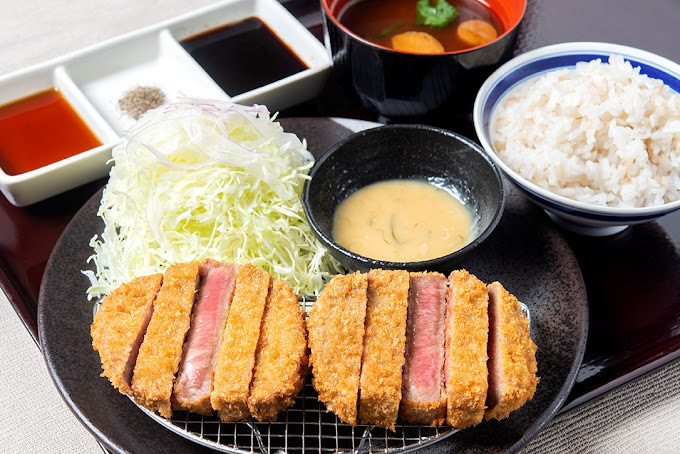
- What They Sell: Beef cutlets (“Gyukatsu”), fried crispy outside, rare and juicy inside. Served as sets with rice, cabbage, soup, and dipping sauces.
- Must-Try Dishes: Sirloin Gyukatsu Set and Tenderloin Gyukatsu Set.
- Budget: ¥2,000–¥3,000 per person.
How to Get to Gyukatsu Kyoto Katsugyu from Nijo Castle
Take Kyoto City Bus 12 from Horikawa Oike bus stop to Shijo Kawaramachi bus stop for ¥230 (12 minutes), then walk 2 minutes to Gyukatsu Kyoto Katsugyu.
b. Unagi Sora
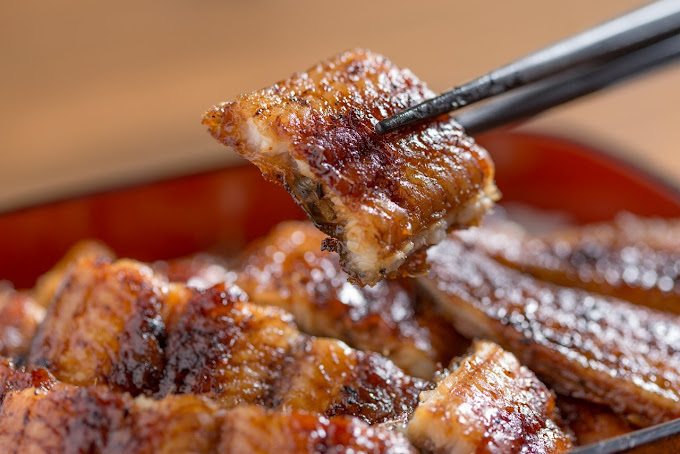
- What They Sell: High-quality grilled freshwater eel (“Unagi”), cooked over charcoal and served over rice with special sauce.
- Must-Try Dishes: Unaju (Eel Rice Box) – Grilled eel on rice, using premium eel (rich, soft, flavorful).
- Budget: Expect to spend ¥4,000–¥7,000 per person.
How to Get to Unagi Sora from Nijo Castle
Take Kyoto City Bus 12 from Horikawa Oike bus stop to Shijo Takakura bus stop for ¥230 (9 minutes), then walk 5 minutes to Unagi Sora.
2:30 PM: Nishiki Market
a. Overview

- What It Is: Narrow, five-block shopping street known as “Kyoto’s Kitchen”; features over 100 food shops and restaurants; specializes in fresh seafood, produce, knives, cookware, and Kyoto specialties.
- History: Over 400 years old; began as a fish market in the early 17th century; chosen for its cold groundwater that preserved fish; gradually expanded to offer diverse food products.
- Why Visit: Perfect spot to experience Kyoto’s food culture; try street food like tamago, skewered meats, and mochi; sample local specialties including matcha sweets and tamagoyaki.
- Atmosphere: Vibrant, covered marketplace bustling with activity; colorful displays create a feast for the senses; blend of traditional and energetic vibes.
- Best For: Food lovers seeking authentic Kyoto flavors; shoppers looking for unique souvenirs like Japanese knives or tea sets; anyone wanting to experience local daily life.
b. Must Try Foods

- Yuba Cream Croquette (Hanayori Kiyoe): Crispy croquettes made with yuba (tofu skin) and cream, offering a crunchy exterior with a creamy filling.
- Soy Milk Doughnuts (Konna Monja): Freshly made, fluffy doughnuts infused with soy milk; slightly sweet and best enjoyed warm.
- Dashimaki Tamago – Rolled Omelet (Tanaka Keiran): Savory rolled omelet made with fresh eggs and dashi broth; popular among both locals and visitors.
- Tako Tamago – Octopus with Quail Egg (Kai): Unique snack featuring small octopus stuffed with boiled quail egg, then glazed and grilled.
- Unagi – Grilled Eel (Ajisai no Toyo): Charcoal-grilled eel glazed in sweet soy sauce and served over rice.
How to Get to Nishiki Market from the Restaurants Above
It’s just a 1 to 5 minute walk from the restaurants listed above to Nishiki Market.
4:30 PM: Nishiki Tenmangu Shrine

- What It Is: Small, historic Shinto shrine at the eastern end of Nishiki Market; dedicated to Sugawara no Michizane, deity of learning and scholarship; popular spot for students seeking academic success.
- History: Founded in 1003; built to honor scholar and politician Sugawara no Michizane who was later deified; survived fires and reconstructions for over a thousand years.
- Why Visit: Perfect quiet break while exploring Nishiki Market; ideal place to pray for success in studies or exams; compact size makes it a quick yet meaningful stop.
- Atmosphere: Distinctive torii gate integrated into surrounding buildings; features traditional lanterns; home to “Nishiki no Mizu” natural spring with pure water believed to bring luck.
- Best For: Students seeking academic blessings; visitors wanting to combine market shopping with spiritual experience.
How to Get to Nishiki Tenmangu Shrine from Nishiki Market
Nishiki Tenmangu Shrine is located at the eastern end of Nishiki Market.
5:00 PM: Shijo and Kawaramachi Streets
a. Overview
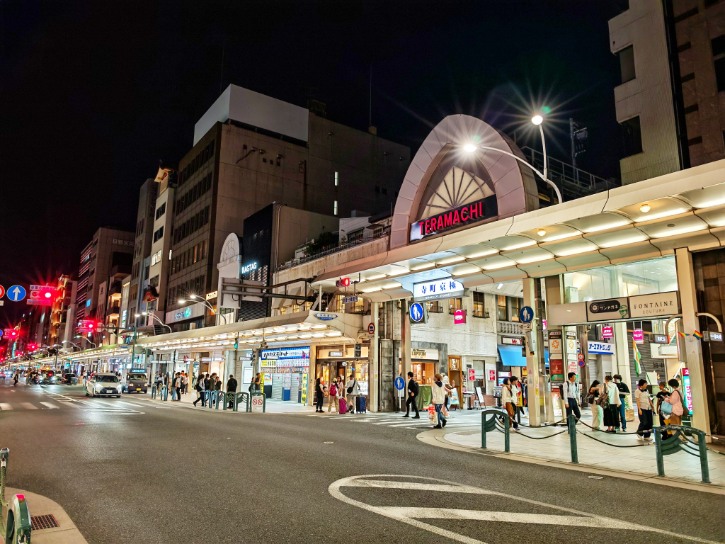
- What It Is: Kyoto’s main shopping and entertainment district located at the intersection of Shijo (east-west) and Kawaramachi (north-south) streets.
- History: Shijo Street dates back to ancient Kyoto as a commercial center; Kawaramachi developed after the late 1500s; became Kyoto’s busiest district by the 1900s.
- Why Visit: Perfect base for exploring Kyoto; walking distance to Nishiki Market, Gion district, and Kamogawa River; offers convenient shopping, dining options, and cultural experiences in one area.
- Atmosphere: Busy and modern with crowded streets, especially afternoons and evenings; main streets feature department stores and neon-lit shops; smaller alleys retain traditional charm.
- Best For: Shoppers, foodies, and those seeking a mix of modern shopping and traditional Kyoto experiences.
b. Luxury Shopping
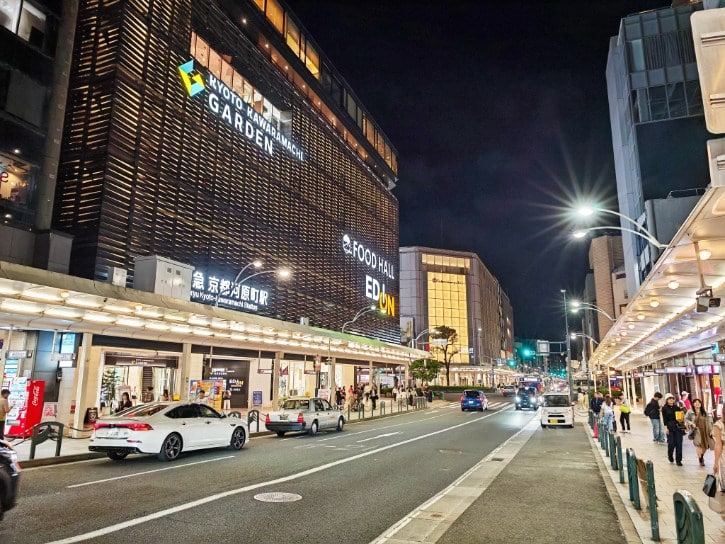
- Kyoto Kawaramachi Garden: Trendy shopping center near Takashimaya with modern fashion and dining.
- Kyoto Takashimaya: Famous upscale department store at the main intersection. Offers luxury brands, cosmetics, souvenirs, and a gourmet food area. Also features the official Nintendo Store with exclusive Nintendo merchandise.
- Daimaru Kyoto: Another upscale department store on Shijo Street featuring high-end fashion, beauty products, and a large food hall.
- Kyoto BAL: Stylish shopping complex on Kawaramachi Street, mixing luxury boutiques with a trendy vibe.
c. Youth and Trendy Shops
- Fujii Daimaru: Popular with younger shoppers for fashionable brands and unique items on Shijo Street.
- Kawaramachi OPA: Multi-level mall with affordable fashion, accessories, and second-hand media, ideal for teens and young adults.
d. Budget-friendly Shopping & Markets

- Disney Store Kyoto Shijo Kawaramachi: Located along Shijo Street near Kawaramachi intersection, offering official Disney merchandise and collectibles.
- Nishiki Market: Kyoto’s famous food market selling fresh local food, snacks, and traditional treats. Great for sampling and souvenirs.
- Teramachi & Shinkyogoku Shopping Arcades: Covered pedestrian streets with affordable clothes, souvenirs, anime goods, and casual eateries. Perfect for budget-friendly finds.
- Don Quijote (Donki): Large discount store near the intersection selling snacks, cosmetics, electronics, and quirky souvenirs, open until late.
- 100-Yen Shops: Daiso and Can Do for affordable snacks, stationery, household items, and small souvenirs.
- Drugstores: Popular options include Matsumoto Kiyoshi (Matsukiyo), Sun Drug, Sugi Pharmacy, and Kokumin, great for cosmetics, skincare products, medicines, and daily essentials.
e. How to Get to Shijo and Kawaramachi Streets from Nishiki Tenmangu Shrine
It’s a 2-minute walk from Nishiki Tenmangu Shrine to Shijo and Kawaramachi Streets.
7:00 PM: Dinner near Kawaramachi Street
a. Tendon Makino Kyoto Teramachi
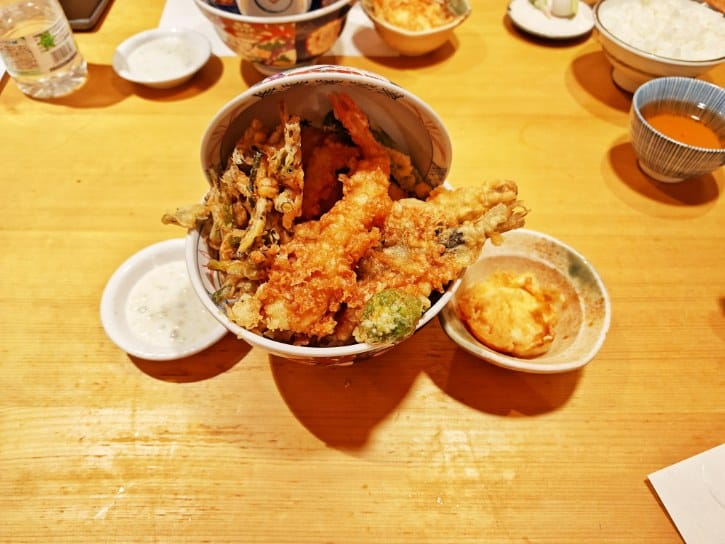
- What They Sell: Specializes in tempura rice bowls (tendon)—freshly fried seafood and vegetables over rice.
- Must-Try Dish: Shoka Tendon includes a variety of tempura items such as shrimp, fish, squid and vegetables
- Budget: Around ¥1,500–¥2,500 per person.
b. Musashi Sushi
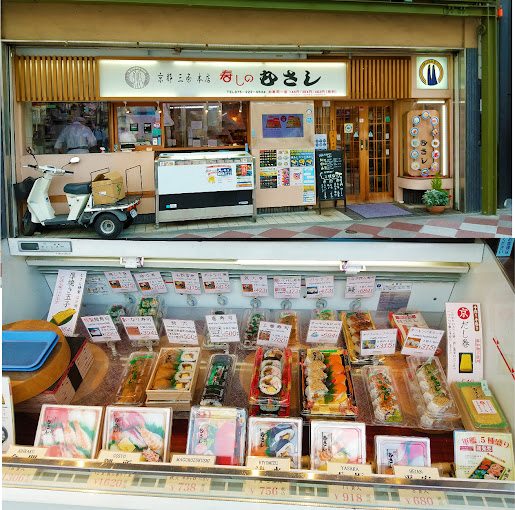
- What They Sell: Popular conveyor belt sushi restaurant offering affordable, high-quality sushi.
- Must-Try Dishes: Tuna (maguro), Salmon (sake), Kyoto-style Mackerel Sushi (battera), Grilled Corn Sushi, and Wasabi Eggplant Nigiri.
- Premium Options: Try sea urchin (uni), fatty tuna (toro), snow crab, or even large boiled shrimp.
- Budget: Typically spend ¥1,000–¥3,000 per person, depending on your choices.
Day 7: Ine Fishing Village and Amanohashidate
On Day 7, you can take a day trip to Ine Fishing Village and Amanohashidate – two hidden gems located about three hours from central Kyoto by public transport.
Since these areas aren’t easily accessible on your own, it’s best to join a guided bus tour, such as Bus Tour 1 or Bus Tour 2.
Let me introduce these two charming locations that you definitely shouldn’t miss during your trip to Kyoto.
1. Ine Fishing Village
a. Overview
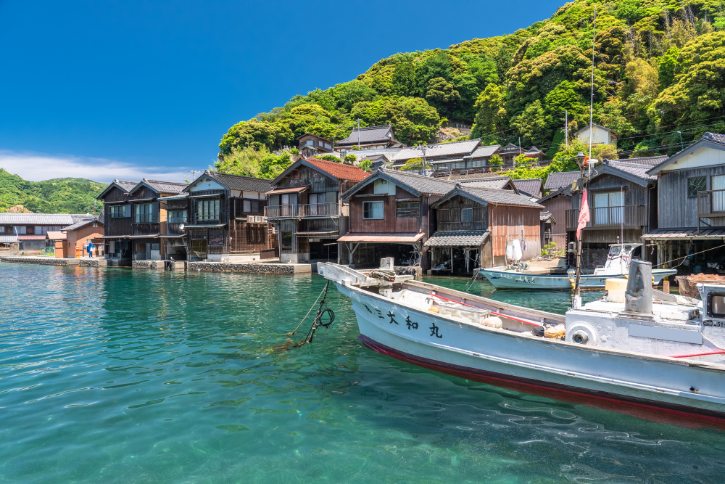
- What It Is: Small coastal village in northern Kyoto; famous for 230 traditional “funaya” (boat houses) built directly on the water; unique setting not found elsewhere in Japan.
- History: Ancient fishing community; iconic boathouses date back to the Edo period; originally built to store wooden boats above water level; now a protected heritage site.
- Why Visit: Experience traditional fishing village atmosphere and beautiful scenery; quieter and less touristy than Kyoto City; perfect for peaceful exploration, photography, and enjoying fresh seafood.
- Atmosphere: Quiet and relaxed with a slow pace matching fishing village life; feels like stepping into old Japan; friendly locals and minimal commercialism.
- Best For: Photographers seeking stunning landscapes; culture enthusiasts interested in traditional architecture; nature lovers enjoying coastal scenery; couples looking for romance and tranquility.
b. Top Things to Do
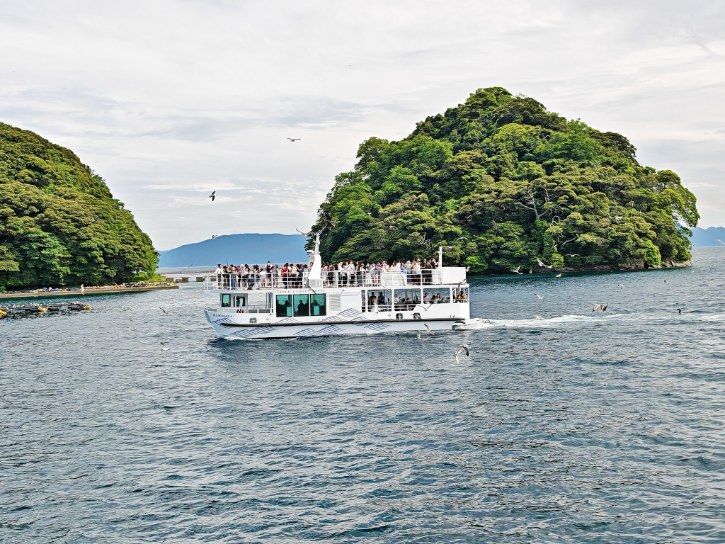
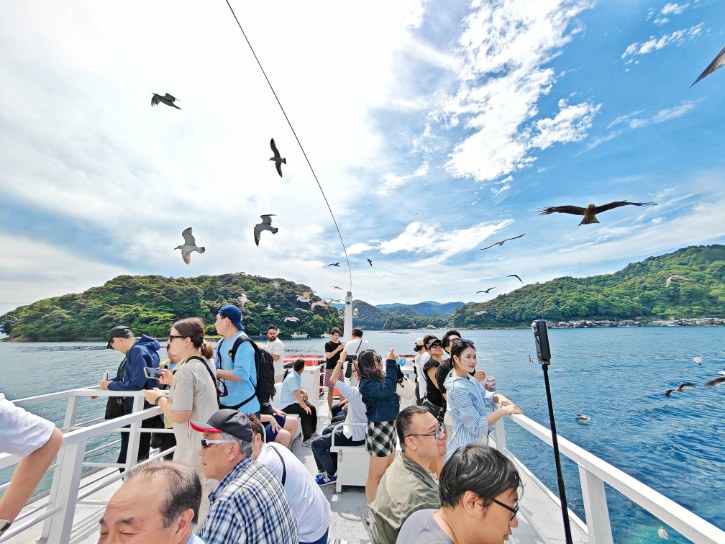
- Funaya Boat Houses: 230 wooden boathouses line the bay; mostly private homes but some converted to guesthouses (minshuku) for overnight stays and authentic experiences.
- Photography Spots:
- Funaya no Sato Park: Hilltop viewpoint offering panoramic bay views.
- Boat Tours: Capture unique angles and water reflections.
- Village Streets: Waterfront walks for close-ups of boathouses and local life.
- Seafood Specialties:
- Ine Restaurant Funaya: Try Kaisen-don (fresh sashimi served over rice) in Funaya no Sato Park.
- Wadatsumi Sushi Restaurant: Enjoy “Wadatsumi Sushi Gozen” or “Funaya Gozen” set meals while overlooking Ine Bay.
- Boat Tours:
- Ine Bay Sightseeing Boat: 25-minute cruise (¥1,200/adult); feed seagulls during trip.
- Sea Taxi: 30-minute smaller boat rides (¥1,000/person) for closer waterfront views.
- Ine Cafe: Cozy waterfront cafe with large windows; famous for cheesecake, chocolate cake, gelato from local milk, and seasonal specialties; perfect relaxation spot with bay views.
2. Amanohashidate
a. Overview
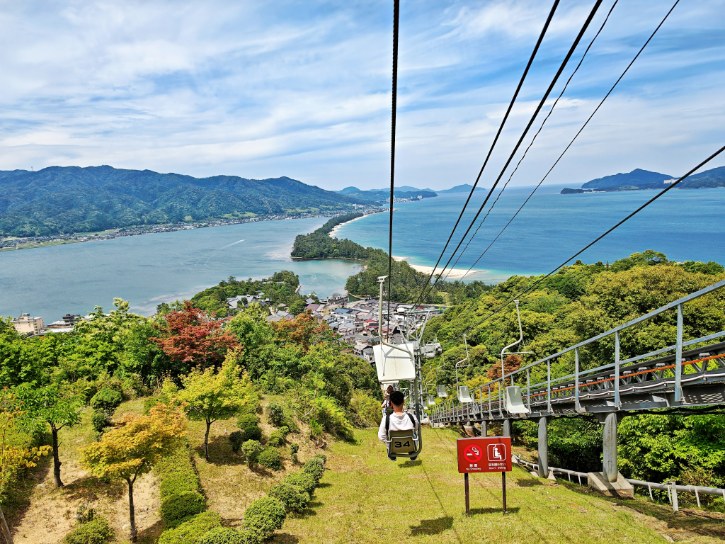
- What It Is: Beautiful pine-covered sandbar stretching 3.6 km across Miyazu Bay in northern Kyoto; known as one of Japan’s “Three Scenic Views”.
- History: Legend says it formed when a ladder to heaven fell to earth; historically celebrated for centuries in poems, art, and local tradition.
- Why Visit: Famous for scenic views; enjoy relaxing beaches and bike-friendly paths; experience the unique “Matanozoki” (viewing upside-down between your legs) where it resembles a dragon or bridge in the sky.
- Atmosphere: Peaceful and scenic; south side (near Viewland) is lively with shops and restaurants; north side (Kasamatsu Park) is quieter and less crowded.
- Best For: Nature lovers, families, photographers, culture seekers, and travelers looking for a relaxing day trip with iconic views.
b. Things to Do in Amanohashidate Viewland
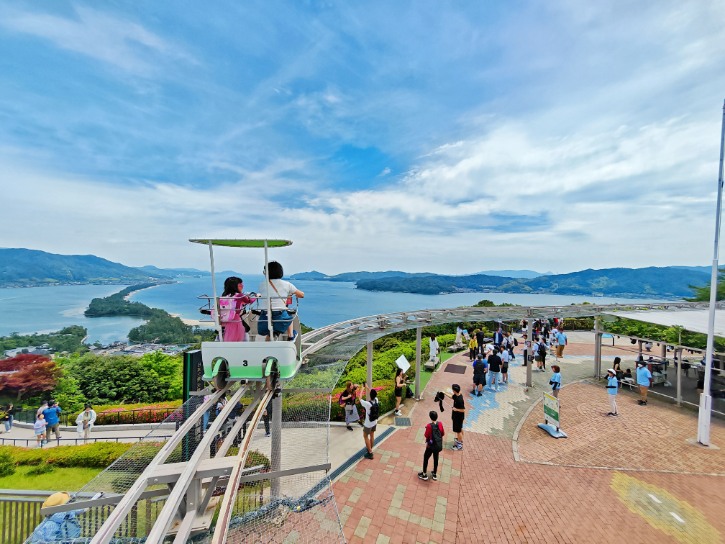
- Cycle-car:
- What It Is: Small pedal-powered carts on elevated rails.
- Experience: Fun, relaxing, and great for viewing Amanohashidate from above. Ideal for families or couples.
- Mata-nozoki Platform:
- What It Is: A platform designed for viewing the sandbar upside-down through your legs.
- Experience: Creates a unique illusion of the sandbar floating in the sky. Fun, easy, and free.
- Hiryukan-kairo (Viewing Sky Path):
- What It Is: Elevated walking path with spectacular views.
- Experience: Feels like walking in the sky above Amanohashidate. Perfect spot for photos.
- Monorail:
- What It Is: Comfortable enclosed rail car transporting visitors uphill.
- Experience: Convenient, family-friendly way to access Viewland. Quick, easy 5-minute ride.
- Chairlift:
- What It Is: Open-air single-seat chairlift.
- Experience: Peaceful and scenic ride with unobstructed views. Relaxing and memorable experience.
c. Things to Do in Amanohashidate Kasamatsu Park

- Observatory:
- What It Is: Viewing platform offering panoramic northern views.
- Experience: Enjoy a stunning perspective of Amanohashidate, perfect for photography.
- Kawarake Nage:
- What It Is: Throwing small clay discs aiming through a lucky hoop (“wisdom ring”).
- Experience: Fun, traditional activity meant to bring good luck or fulfill wishes.
- Matanozoki:
- What It Is: Famous upside-down viewing tradition originated here.
- Experience: Turn your back to the bay, bend over, and look through your legs. Makes Amanohashidate appear as a dragon rising to the heavens.
- Cable Car:
- What It Is: Small enclosed tram taking visitors up and down the mountain.
- Experience: Comfortable ride, suitable for all visitors, especially families or those uncomfortable with open-air chairlift.
- Chairlift:
- What It Is: Open-air single-seat Chairlift transporting visitors uphill/downhill.
- Experience: Relaxing ride with unobstructed views, ideal for a peaceful and scenic ascent or descent.
Read More: A Complete Day Trip Guide to Amanohashidate and Ine Funaya from Kyoto or Osaka
3. Dinner near or at Kyoto Station
a. Kyoto Ramen Koji

- What They Sell: A ramen hub on Kyoto Station’s 10th floor with 8 regional ramen styles under one roof.
- Must-Try Dishes:
- Gion Miyako Ramen: Rich chicken broth ramen with raw veggie toppings.
- Chicken Salt Ramen: Clear, flavorful chicken-based broth seasoned with salt, served with tender chicken slices. Great option if you prefer lighter ramen.
- Budget: About ¥700–¥1,200 per bowl.
b. Daiki Suisan Kaitenzushi Kyoto Tower Sand
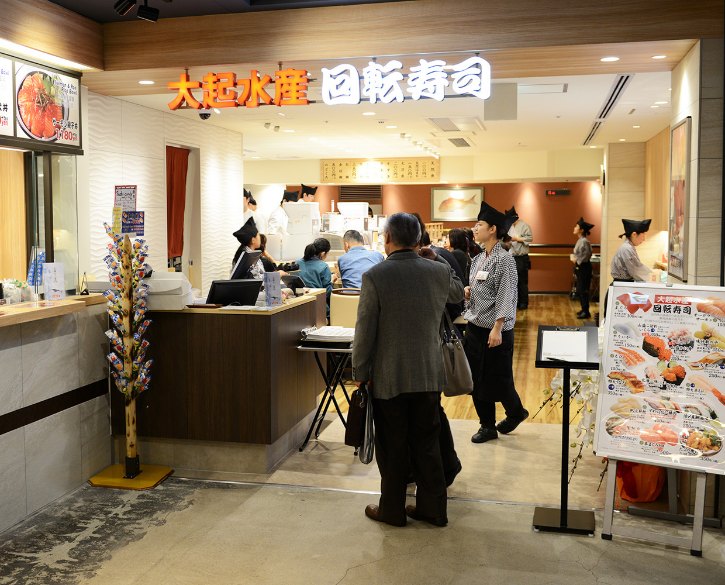
- What They Sell: Conveyor belt sushi (Kaitenzushi), offering fresh, affordable sushi plates located in the basement of Kyoto Tower.
- Must-Try Dishes: Fatty Pacific Bluefin Tuna, Aurora Salmon, Red Snow Crab, Grilled Eel, and Salmon Roe.
- Budget: Budget-friendly. Plates start at around ¥110 each. Typical meal ranges between ¥1,500–¥2,500 per person.
Leaving Kyoto for Kansai International Airport
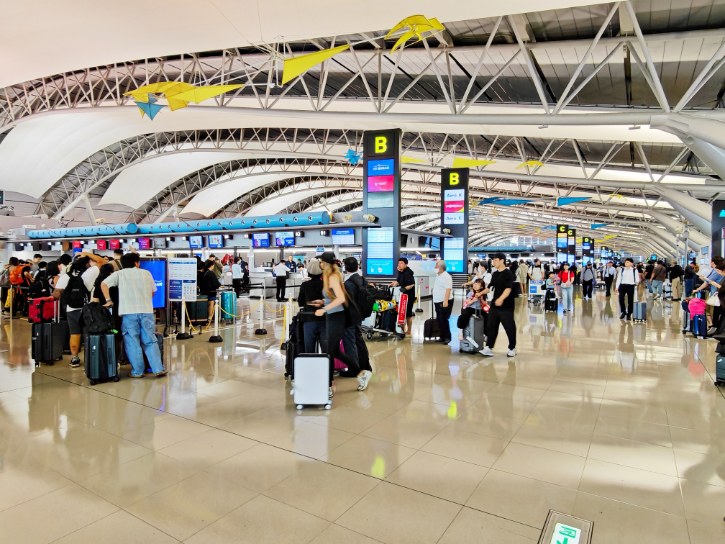
If you’re leaving Kyoto for Kansai International Airport on the evening of Day 7, it’s best to visit Ine Fishing Village and Amanohashidate on Day 6 to avoid any risk of traffic delays.
However, if you’re departing from Kyoto the next morning, you can take the day tour on Day 7.
Below are the steps to reach Kansai International Airport from Kyoto Station:
- From Kyoto Station, take the JR Haruka Express train directly to Kansai-Airport Station.
- The journey lasts around 1 hour and 25 minutes and costs ¥2,200.
- The first train departs at 5:45 AM, and the last train departs at 8:30 PM.
Take Note: Morning peak hours in Kyoto are typically from 7:00 AM to 9:00 AM. If you plan to travel during this period, it’s advisable to depart earlier to avoid potential congestion.
Related Posts
Photo Credit:
Photos by PIXTA

